The Complete History of the Klingons in Star Trek's Next Generation Era
After the Star Trek heroes began the historical peace process, relationship of the Federation and the Klingons still weren't always allies or friends.

Quick Links
The next generation introduced the klingon-federation alliance, deep space nine changed klingon and federation dynamics in an explosive way, the klingon and federation go to war against the dominion, the end of the 24th century brought a return to klingon and federation peace.
While Klingons are thought of as the biggest antagonists in the history of the Federation, the majority of Star Trek stories take place when they are at peace. The end of Star Trek: The Original Series era of films included the beginnings of an alliance initiated by Spock and Captain Kirk, though reluctantly. While peace was never easy or all that long-lasting, the Klingon Empire and Starfleet are just as often allies as enemies. Making peace with the Federation was always something controversial among the war-obsessed Klingons. Through multiple versions of treaties, alliances and agreements, some Klingon ship and its crew were always hassling some Starfleet or Federation target. However, the Romulan Star Empire's reemergence helped bring them closer together.
In 2344, a Klingon outpost on Narenda III was attacked by the Romulans. The USS Enterprise-C under Captain Rachel Garrett tried to help and was destroyed after a brief time-travel excursion changing Star Trek canon. This sacrifice led to very productive peace talks, which themselves came under attack by Romulans two years later. Ja'rod of House Duras betrayed the Klingons, but he blamed Mogh (Worf's father), whose son was sent away and was raised on Earth. Another prominent Klingon, Martok was given a field commission while fending off a Romulan attack. The most solid alliance between the Federation and Klingons came in 2349 when Riva (whose name came to mean "peacemaker") negotiated a lasting peace with Federation leaders, including Sarek, father of Spock.
William Shatner Joins Leonard Nimoy's Family in Remembering the Star Trek Legend
The treaty Riva negotiated led to a powerful political alliance between the Federation and the Klingons . The Empire was even described as being a tertiary part of the United Federation of Planets. However, errant Houses continued to attack Federation targets, and anti-alliance leaders like Korris emerged because they believed their leaders were traitors. Still, Starfleet and the Klingons participated in officer exchanges, and they even fought in some battles together, mostly against Romulans. Klingons assisted the USS Enterprise-D in trying to help Admiral Jarok defect, and provided a Bird of Prey for Picard and Data's covert mission to find Spock on Romulus.
Still, there were Klingons who chose the Romulans over the Federation. Ambassador Kell who worked with Sela (the daughter of an alternate timeline Tasha Yar ) to frame the Federation for the murder of a Klingon governor. While the peace with the Federation was maintained, it wasn't so for the Klingons themselves. A civil war broke out in the Empire deposing the longest ruler in Klingon history, K'mpec. Duras, son of Ja'rod, led a faction that wanted to break ties with the Federation and make the Klingons more warlike. He was killed by Worf in revenge for Mogh's death around 2367. After this, Worf's half-brother, Kurn, had to live in hiding as "Rodek"
Klingon women could not lead a house, so Duras's sisters Lursa and B'Etor put forth their half-brother Toral to stand against the more Federation-friendly successor to K'mpec, Gowron. However, the previous chancellor named Captain Picard as the "Arbiter of Succession," rejecting Toral's claim. The ensuing Civil War was fanned by Sela and her new Klingon Ally, General Movar. As the Enterprise and Starfleet tried to maintain a blockade of Romulan and Klingon space, quick-thinking by Data revealed the cloaked Romulan ships providing aid to House Duras. Gowron won the Chancellorship, and he was mostly friendly to the Federation .
Star Trek 4 Gets Back on Course With New Screenwriter Revealed
Under Gowron, the Klingons helped to engage the Borg, though it is unclear if they were aiding Starfleet or being attacked themselves. Also, in 2369 clerics at a monastery in Boreth cloned Kahless the Unforgettable , the legendary Klingon leader. This was to fulfill the prophecy that he would return from Klingon Heaven, Sto-va-kor. However, he became a "moral" leader while Gowron retained his position. When the wormhole to the Gamma Quadrant was discovered near Bajor and Deep Space 9, relations grew tense, especially once the Dominion became a threat.
Before the outbreak of open hostilities, the Changeling Founders replaced General Martok with an imposter, who forced Gowron to antagonize the Federation, even ending the alliance. At the same time, the Klingon Empire invaded the Cardassian Empire, which Starfleet and the Federation opposed. Captain Benjamin Sisko convinced Gowron to end his campaign, but the alliance was not restored. The phony Martok's influence created tension between Starfleet and the Klingons, but Gowron's desire to appear in complete control made them think he was the Changeling imposter.
Eventually, the Klingons declared war on the Federation over territory on the shared galactic border. The two forces battled for weeks until Starfleet revealed the Changeling infiltration and return the true Martok. At the same time, the Cardassian Empire joined the Dominion. These reinforcements almost decimated the Klingon Fleet. Gowron and the survivors travel to Deep Space 9, where he rejoins the Khitomer Accords and allies with Starfleet to fight the Dominion in 2373.
Star Trek: Section 31 Will Debut a Younger Version of a Next Generation Character
The Federation and Klingon alliance was effectively based out of Deep Space 9, with Captain Sisko and General Martok leading the forces . Each had to answer to their respective superiors, but the two leaders formed a bond. A year later, the Romulan Empire joined the alliance , after Sisko aided the Cardassian spy and tailor Garak in framing the Dominion for the death of a Romulan ambassador. The three-way alliance turned the tide of the war and put the Dominion on the defensive.
Eventually, the Dominion recruited the elusive Breen species into their Empire, and with them a weapon that drained power from starships. The Klingon fleet was the first to adapt to this weapon. However, instead of helping their allies, General Martok led these forces on an ill-fated offensive against the Dominion. This was a ploy by Gowron to sully Martok's reputation, lest he become a political rival. If he won the war without the help of Starfleet or the Romulans, it was Gowron's plan. If he failed, then Martok took the blame and Gowron's position was safe. Martok didn't fail.
Gowron eventually took over the command of the Klingon forces at Deep Space 9, sidelining Martok. Worf, an adopted member of Martok's house and the first Klingon in Starfleet, challenged Gowron in a fight to the death for leadership of the Empire . Worf won the battle and named Martok as the Chancellor of the Klingon Empire. Under his leadership, the alliance defeated the Dominion in a decisive battle on Cardassia Prime.
Section 31: First Image of Michelle Yeoh in New Star Trek Movie Released
Since the end of the Dominion War, the Klingons have kept mostly to their own territory . Starfleet intelligence estimated the Klingons would take a decade or more to recover from their losses of people and material from the Dominion War. Worf took a leave of absence from Starfleet to work with Martok, though he did return for select missions on the USS Enterprise-E until it was destroyed. By the first years of the 25th Century, Worf was both a member in good standing of the Klingon Empire and working as an intelligence contractor for Starfleet.
In the late 24th Century, a group of Klingons was part of former Starfleet cadet Nick Locarno's plan to create his own fleet, complete with Genesis Device. Beckett Mariner and the crew of the USS Cerritos were able to stop him. Otherwise, the Klingons have kept mostly to themselves. If they are still traveling space and picking fights, but not with Starfleet. In the 32nd Century ( where the USS Discovery time-traveled to from 2258), the galaxy had been decimated by "The Burn." This cataclysm destroyed most of the dilithium in the galaxy, which powered warp drives for all species.
The crew essentially found a planet made of dilithium, and the space-faring civilizations of the Federation and its adjacent territories returned to normal. However, the USS Discovery has not encountered any Klingons in that time period. It's possible after the Burn, they resorted to war, both with other species and within the Empire, again decimating their population. If not, the Klingon Empire continues to keep to itself and stay out of galactic affairs .
The Star Trek universe encompasses multiple series, each offering a unique lens through which to experience the wonders and perils of space travel. Join Captain Kirk and his crew on the Original Series' voyages of discovery, encounter the utopian vision of the Federation in The Next Generation, or delve into the darker corners of galactic politics in Deep Space Nine. No matter your preference, there's a Star Trek adventure waiting to ignite your imagination.
From Star Trek: Theurgy Wiki
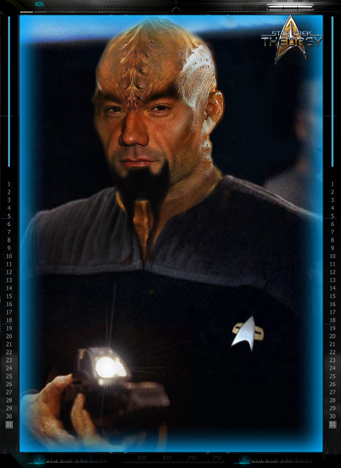
- Valkra (KIA)
- K'Lara Halliwell (KIA)
- Erev-Sae-Reyanad Xan (Stasis)
- Kyle Jensen (KIA)
- Mickayla MacGregor
- Zaraq (KIA)
- Scosche Bellde'side (KIA)
- Nerina (KIA)
- Khorin Douglas (Stasis)
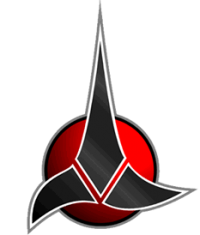
The Klingons were a humanoid warrior species that originated from the planet Qo'noS (pronounced Kronos). Originating from the planet Qo’noS in the Beta Quadrant , the Klingon Empire was a warrior dominated species and one of the major powers in the Galaxy. While there had been hostilities between the Federation and Klingons in the past, since the signing of the Khitomer Accords in 2293, the two powers had been considered allies despite several small skirmishes. One of the major powers of the galaxy, the Klingons were a proud, tradition-bound people who valued honor and combat. The aggressive Klingon culture had made them an interstellar military power to be respected and feared.
In 2381, the Klingon Defense Force was the modern successor to the '''Klingon Imperial Fleet''', which was the Empire’s primary space-based military force in the 22nd and 23rd centuries. It was a multi-faceted organization charged with protecting the Klingon people from all external threats as well as those originating from within its borders.
For information on Klingon Great Houses , see this page .
- 1 Physiology
- 3 Organization
- 4 Klingon Oversight Council
- 5 Order of the Bat’leth
- 6 Order of Kahless
- 7 Imperial Intelligence
- 8.1 The Mok’bara
- 8.2 Bladed Weapon Training
- 8.3 Energy Weapon Training
- 8.4 Officer Training
- 8.5 Rank Comparisons
- 9 Assignment in the Klingon Defense Force
- 10.1 Landing Parties
- 10.2 Survey Parties
- 10.3 Occupation Forces
- 10.4 Boarding Parties
Klingons were a species of bipedal tetrapod with a head, neck, torso, and four limbs that made up their body plan. They were a species that possessed anatomy and physiology remarkably similar to humans, but with several noticeable divergences. The most striking feature of Klingon anatomy was their cranial regions, which possessed striking sagittal crests which varied greatly between individuals, though familial lineages may possess similar crests. This was largely due to a protective exoskeletal casing which enveloped their craniums, though a shattering blow to the tricipital lobes of these casings can result in certain death. The rest of Klingon external anatomy was heavily ridged, with ridges on their feet, chests, and notably, a crest of ridges and spines which ran down their backs. Furthermore, male Klingon genitalia, while similar to humans, also possessed a series of ribbing and ridges along the shaft. Klingon skin tones tended to range from an olive tone, to brown, to an almost charcoal-black. Both sexes possess hair on their heads which was typically black or brown, and turned grey with age.
Internally, Klingon physiology was markedly different from human anatomy, and possessed numerous redundancies in a biological principle called brak’lul. Klingons possessed eight-chambered hearts, two livers, multiple stomachs, three lungs, and even redundant neurological functions. This rendered a Klingon with incredible stamina to resist injuries which would be debilitating for a human . However, unlike humans, Klingons possessed a notably decreased tolerance for cold temperatures, largely due to their own lower body temperatures.
There was a time when the Klingon military was geared toward little more than conflict and conquest. Indeed, the history of the Empire was built upon the conquest of other worlds and their people. After enduring the Hur’q invasion, the plundering of Qo’noS, and near annihilation, the Klingon people marshaled sufficient numbers and resources to mount a resistance against their oppressors. The costs of rebellion were high, nearly extinguishing altogether what remained of the Empire, but eventually, the slaves turned back their masters.
After expelling the Hur’q from Qo’noS and reverse- engineering the technology they left behind, the Empire took to the stars, expanding outward first to colonize uninhabited planets and later to worlds that already were home to indigenous sentient populations. Unlike the Federation Starfleet and its overtures of peace and cooperation for mutual benefit, the Empire was driven by a single goal: conquest. The Imperial Fleet was the instrument of this agenda, establishing military garrisons on dozens of planets, forcing their native civilizations into line, and ensuring they acted to serve the Empire’s interests. Most of these societies fell into line, motivated either by simple self-preservation or the realization there actually were benefits to being jeghpu’wI’, or “the conquered people.” Indeed, by 2381, it had been more than two centuries since a subjugated world has attempted to overthrow Klingon rule.
War was not uncommon to those serving in the fleet or its associated ground forces. While many worlds yielded to the banner of the Empire, others fought with the same conviction which had fueled the Klingons’ fight against their Hur’q oppressors centuries earlier. These civilizations mounted their own defense, vowing to resist subjugation at all costs.
More often than not, such pledges were fulfilled and Klingon occupation forces took what remained of the world anyway. On other occasions, a people managed to defeat Klingon forces to the extent that the Empire showed its respect by halting invasion attempts. In some instances, accords were reached and treaties signed, while other worlds were left to pursue their own destiny free from further aggression. It was the ultimate compliment the Empire could pay to an enemy who fought with such tenacity.
Inevitably, these expansion efforts brought them into contact with space-faring civilizations capable of matching Klingon warships in terms of military capabilities. Chief among these potential rivals were the Humans of Earth and the Romulan Star Empire . The Humans in particular posed an interesting challenge, in that while they displayed the technology and the ability to fight when pressed, they preferred non-aggressive action to conflict. In the two centuries since first encountering Humans, many Klingon commanders have commented on the seeming inconsistency of their attitudes and actions. While they can be duplicitous, Humans also are capable of demonstrating their own form of honor. Early encounters were characterized by actions taken regardless of the risk to their personal safety while being of benefit to the Empire. Their contradictory nature was at times confusing, intriguing, and frustrating, and numerous Klingon military leaders cautioned against underestimating these seemingly weak specimens. This prudence was justified on more than one occasion when the Empire found itself at odds and even at war with Earth, the people of which by then had assembled an interstellar coalition, the Federation , to extend its own influence farther away from their homeworld.
The Human ability to foster collaboration was amply demonstrated in the 22nd century when they enlisted the assistance of the Andorians to defeat the Xindi, disrupting that species’ agenda of destroying Earth. Humans followed this with an alliance of the Vulcans , Andorians , and Tellarites to defeat the Romulans and send them retreating behind their borders for more than a century. By the time this coalition grew into the United Federation of Planets , wise Klingons realized this new union was not to be taken lightly. Those charged with maintaining the readiness of the Klingon military apparatus began altering their training, tactical studies, and resource allocation and development with an eye toward the challenges posed by the Federation as a formidable adversary.
Historians considered this era the impetus that forced the Empire to enter a period of reflection and assessment. Klingon leaders began to examine their priorities. War and skirmishes of varying intensity with the Federation , the Romulans, and other prominent neighbors forced expansion and resource location and acquisition initiatives to turn away from these rivals and toward other, largely uncharted regions of space. Despite a strong desire for conflict and the base need to fight so as to avoid being vanquished, efforts at outright conquest slackened. By the time the Empire signed the Khitomer Accords in the late 23rd century, such ventures were on the decline. Decades later, after the Federation demonstrated its willingness to stand with their allies, first during key battles at Narendra III and the Khitomer outpost and later during the Dominion War , Klingon leadership began to realize this bond – forged from conflict, tested by mistrust and uncertainty, and ultimately sealed by standing together before a common enemy – was not a fleeting aberration. With that in mind, the mission of the Klingon Defense Force was realigned to reflect what its name implied: protecting the security of the Klingon people, a mandate broadened and strengthened by its ability to unite with the Federation Starfleet during times of crisis while still upholding its promise to safeguard the Empire.
Unlike Starfleet and similar organizations authorized by their respective governments, the KDF was a purely military organization. It was by far the Empire’s single largest recipient of funding, resources, and personnel. Despite what some argue was a “softening” of its agenda with respect to expanding Imperial influence, the KDF still symbolized the warrior ethos espoused not just by its soldiers but also all Klingons. The lessons of the past continued to inform the actions of the present and the visions for tomorrow. Even if it meant fighting to the last breath of every man, woman, and child, the Klingon Empire will never again bow before an enemy.
In 2376, a coup against Chancellor Martok was designed to throw the Klingon Empire into chaos and allow the two Klingons Morjod and Gothmara to become the new rulers of the Klingon people. This coup against Martok was ultimately unsuccessful, and Morjod and Gothmara were killed. Instead, the alliance with the Federation continued to prosper. In 2379 the two worked together in the construction of the Unity One station. The Unity base was an advanced starbase, representing the accomplishments of the alliance. As part of the design, the station's sophisticated sensor array allowed it to detect even cloaked vessels that were many sectors away.
In 2380, as the Romulan Civil War raged in full, Chancellor Martok accepted the Remans as a protectorate of the Klingon Empire , resulting in Klingon vessels entering Romulan space. Through the year, Klingon forces were involved in a number of skirmishes within Romulan space. After continued attacks and the failure of the Remans to successfully settle on the Ehrei'fvil continent of Romulus , the Klingons allowed the Remans to settle on a planet within the Klingon Empire.
Later in 2380, Chancellor Martok attended a conference with the Federation President and the Romulan Praetor regarding the founding of the Imperial Romulan State . Rather than denounce the new government of Commander Donatra , now Empress of the Imperial Romulan State, Martok instead gave his approval to the new state, recognizing its sovereignty.
Organization
Each of the Great Houses maintained its own military forces, descended in many ways from the armies which once fought one another across the surface of Qo’noS for territory and resources before the Age of Kahless. In the modern day they served as militias of limited size and scope, tasked primarily with defense of the regions from which their parent Houses resided and served as first response organizations in the event of natural calamity. Additionally, these units maintained their training, vessels, equipment, and preparation activities, available at a moment’s notice to be called into Imperial service by direction of the chancellor or the High Council. Training consisted of deployment readiness exercises away from the homeworld where their ships and ground units carried out mock battles of the sort they will be expected to fight once called to action. Until activated, these armies remained separate entities from the KDF.
Likewise, the KDF existed as a self-contained military structure, falling under the authority of the Military Commission of the High Council. This commission, known as the High Command, was led by the Chancellor and consisted of the KDF’s uppermost leadership cadre. Staffed by five generals, this command also served as the Chancellor’s direct military advisors and also counseled other members of the High Council as needed. All military action directed by the Chancellor was based on information and counsel provided by the generals of the High Command, who in turn communicated the chancellor’s orders and intent to the KDF’s senior commanders for implementation.
Originally located in the First City on Qo’noS, the KDF Command Headquarters resided on the planetoid Ty’Gokor. The installation consisted of a heavily fortified command center, the bulk of which was constructed beneath the planet’s surface. Ty’Gokor was protected by a defensive shield as well as an orbital network of unmanned defense craft charged with protecting the planetoid itself, as well as the spacedock and shipbuilding and maintenance facilities parked in high orbit. An armada of thirty warships including flagships for the generals of the High Command were also deployed to the region at all times. In addition to the KDF’s leadership cadre, the planet was also home to a robust command, control, and communications center tasked with overseeing the movements of every vessel in the Klingon fleet. All orders and other dictated from the chancellor, the High Council, or the High Command were funneled through this organization. Imperial Intelligence also had facilities located here, though this contingent operated independently of the KDF command structure. The Hall of Warriors occupied a revered chamber within the central command facility and played host to various ceremonial functions, upholding traditions that had been a part of the KDF and its predecessor organizations dating back to the Age of Kahless.
The first of two elements composing the KDF was the Deep Space Fleet, which was a provisional component that was only activated by calling the militaries of the Great Houses to service. At this point, the High Command assumes authority of this assembled force, which was comparable in size and capabilities to the Federation’s Starfleet or the Romulan military. When the Empire finds itself prepared for conflict, these were the first warriors sent to battle far from the homeworld.
Operating in parallel with the Deep Space Fleet was the Internal Security Force . This was a permanently staffed element, with its own command hierarchy, assets, and operational mandates. Also answerable to the High Command, the ISF was responsible for patrolling Imperial space, staffing and maintaining observation and tactical outposts along the borders, colony support and defense, law enforcement including anti-piracy and interdiction, customs and other regulatory enforcement, and search and rescue. Vessels and personnel from the Great House fleets could be called upon by the High Council to augment ISF assets. In times of conflict, the ISF operated in tandem with the Deep Space Fleet, acting in accordance with the direction of the High Command.
While rank and station were obvious components of Klingon 's military structure, both of these were viewed in tandem with an individual warrior’s commitment to the principles of personal honor and dedication to the accomplishment of any assigned mission for the glory of the Empire. Failure to meet such expectations was viewed as a grievous assault on one’s own honor as well as that of their fellow warriors and superior officers. Warriors who demonstrated an inability to meet these demands and commitments were expected to be disciplined if not executed as punishment for their actions. Indeed, any Klingon who failed to address such deficiency stood the risk of being penalized.
Klingon Oversight Council
Usually composed of a dozen officers, all ranked commander or higher, the Oversight Council was tasked with approving the selection of officer candidates for the KDF. This group was often viewed by many veteran warriors as a “simple formality,” particularly when considering most defense force officers were applicants drawn from one of the Great Houses. Legacy selection – the practice of accepting new recruits from families possessing a long history of honorable military service – filled most available openings for new candidates. After completing the standard entrance examination, would-be officers only required a recommendation from a sponsor, usually an active or retired officer in good standing with the High Command. Once this was obtained, the recruit was sent on for the basic training required of all warriors at one of the KDF’s indoctrination centers. Upon completing that initial phase, officer candidates received additional instruction at veS DuSaq, the “School of War.”
While this aspect of the selection process was indeed routine and largely predictable, the Oversight Council also reviewed applications and entrance examinations submitted by instructors at the various indoctrination centers. If a recruit showed unusual aptitude or potential to succeed as an officer, they were flagged for additional scrutiny while still undergoing basic training. Upon graduation and assuming they had passed all of the entrance and review requirements, they were transferred from the enlisted ranks to veS DuSaq to receive officer candidate training in the hopes of earning a commission. Fewer than fifty recruits received this recommendation each year as the review process was rigorous. Potential candidates were not even informed they were being considered for this program until they graduate basic training.
Order of the Bat’leth
An elite group within the Klingon Defense Force, the Order of the Bat’leth was a recognition bestowed upon those warriors who had demonstrated remarkable courage and achievement in battle. It was considered one of the highest awards any Klingon could receive, subordinate only to the Order of Kahless or being declared a Dahar Master. It was created by Lukara, wife of Kahless the Unforgettable, after his death, vowing that this exclusive fraternity would always exemplify the warrior ethos and the highest measure of personal honor and courage as personified by her husband. Today, selection of new inductees was conducted by a committee of six elder members and overseen by the Chancellor of the High Council. Requirements for entry were arduous and cloaked in secrecy, known only to those charged with verifying the worthiness of potential inductees. Warriors admitted to the Order were forbidden from speaking of its members, practices, and ceremonies. Of the fewer than twenty Klingons admitted each year to the Order, as few as a third and as many as half of the selections were posthumous inductions.
Induction ceremonies were held once a year at the Klingon Defense Force’s command headquarters on Ty’Gokor, with mandatory attendance for all living Order members as well as the general staff of the Klingon Defense Force’s High Command and even the Chancellor. The official ceremony was conducted following a day of celebration that included the consumption of much bloodwine, friendly contests of strength and fighting prowess, and raucous fellowship. All of this tended to be viewed by the Order’s older members in somewhat more than light-hearted fashion as but one more test for new inductees, a final means of verifying their worthiness to join their respected comrades in arms.
As the Order of the Bat’leth was a distinction reserved to those who had served with valor far above even the strict demands of duty and honor, once the award was bestowed even the Chancellor was prohibited from rescinding it. Display of the Order’s symbol on one’s uniform signified to all who saw it that its bearer was recognized as one of the Empire’s truly elite warriors.
Order of Kahless
More exclusive in nature than even the Order of the Bat’leth, those Klingons selected for the Order of Kahless were recognized for honorable service to the Empire over a sustained period of time, during which the warrior was shown to have conducted themselves with unwavering bravery and selfless sacrifice regardless of personal risk. Only the Chancellor of the High Council carried the power to so recognize an individual. Those who earned the distinction received the Star of Kahless, one of the highest decorations the Empire can bestow, and its wearer was to be known for all time and without question as a warrior in the finest tradition of Kahless himself. As of 2381, fewer than ten living warriors held the Star of Kahless, with Chancellor Martok being the only Klingon to earn the honor before ascending to that position.
Imperial Intelligence
On par with other secretive organizations such as the Federation’s Starfleet Intelligence , the Romulan Star Empire’s Tal Shiar, or the Cardassian Union’s Obsidian Order , Imperial Intelligence was a clandestine component within the Klingon Defense Force. Its primary mission was the gathering and analysis of information obtained from other interstellar powers using all manner of covert means. Though it did occasionally conduct sanctioned activities against Klingon citizens, its main focus was observing, studying, and even acting against individuals and activities deemed to be of concern to the security of the Empire.
A significant aspect of Imperial Intelligence efforts involved espionage utilizing agents surgically altered to appear as members of the species being spied upon. Individuals trained for such duties underwent rigorous screening, evaluation, and training processes to determine their ability to work independently for extended periods of time. Agents who received these types of assignments were embedded behind enemy lines, often pursuing their mission for years without support. Such operatives were tasked with finding ways to insert themselves into low-level positions within a government or military organization. From these vantage points, agents collected relevant information, either from first-hand observations or by infiltrating facilities, computer systems, and data storage archives. On infrequent occasions these individuals may have been called upon to take actions designed to undermine the efforts of an adversarial power. This could take the form of simple disruption of political agendas to outright sabotage of installations or ships and even assassination of key individuals. Agents killed or captured while on assignment were disavowed, and failing to carry out one’s mission was considered a grave dishonor not just to the operative but also their family. Those who managed to return to the Empire often faced severe consequences, including discommendation and exile.
The life of an intelligence agent was not for every Klingon , but those who choose to answer this call to duty knew that they and others with similar convictions played a vital role in safeguarding the Empire and all Klingon people. In 2381, Councilor K'Tal of the House K'Tal was the Head of Imperial Intelligence.
Those wishing to serve as soldiers in the Klingon Defence Force had to first complete a grueling training regimen that taxed body, mind, and warrior spirit to their absolute limits. For uncounted generations, candidates had submitted themselves to the unforgiving instructors of the KDF’s basic military indoctrination centers. Raw recruits spent nearly four months suffering through all manner of tests measuring their physical strength, endurance, mental acuity, and psychological readiness to undertake the demands of military service. What might appear as vindictive if not absolutely sadistic actions on the part of the instructors was in fact a meticulously choreographed exercise. No detail was overlooked as teachers and drill masters put recruits through their paces day after grueling day.
The Mok’bara
A key aspect of training that began during basic indoctrination and continued throughout a warrior’s career was acquiring and maintaining a proficiency in the Mok’bara. This ancient fighting discipline was the foundation upon which all Imperial hand-to-hand combat techniques are built. It was as much about mental focus as it was physical prowess, forcing the student to become attuned to their body’s every movement, not just when practicing the form but in all other aspects of one’s life. It had been compared to Vulcan techniques of Suus Mahna or the Human disciplines of tai chi or aikido. However, those forms were noted for their emphasis on defensive techniques, whereas Mok’bara students learned how to attack as well as protect themselves. Introduction to the form began within the first days of basic training, and as the cycle progressed candidates learned unarmed fighting techniques before incorporating bladed weapons. Recruits had to advance to the first recognized Mok’bara rank level, chu’wl’Hey or “advanced novice,” as a requirement of graduating military indoctrination. From there, warriors were expected to maintain their studies and advance their ranks and skills. It was not uncommon for senior officers and enlisted soldiers within a unit or ship’s crew to be recognized as Mok’bara masters.
Bladed Weapon Training
Once recruits were comfortable with the initial techniques and forms, instructors began integrating knives and swords into training exercises that brought an added dimension to hand-to-hand combat. While the term implied and was often used to describe fighting without the aid of weapons, blades were often employed in such situations. Thanks to family heritage and upbringing, many Klingons had already received an introduction to a variety of bladed weapons before arriving at an indoctrination center. Such exposure paled in comparison to the grueling drills and other exercises designed to hone each warrior’s proficiency with these implements. Many warriors considered fighting with a bat’leth, mek’leth, or d’k tahg to be battle in its purest form, challenging an enemy face to face and fighting until there was but one undisputed victor. It was a mindset which had defined Klingon heritage and supremacy in conflict from the time of Kahless the Unforgettable. As with other facets of recruit training, instruction and drills in this area increased in difficulty to the point that when a candidate graduated, they were able to wield such weapons as if they were extensions of their own body.
Energy Weapon Training
For energy-based weapons, the training was no less important or focused. Warrior candidates received their initial instruction within the first weeks of basic indoctrination. Laced through this instruction was a continuous, extensive series of weapons familiarization classes. Candidates began with static, known-distance marksmanship instruction using disruptor rifles and pistols. Scores were tracked throughout the entire training cycle and competition among classes was fierce. Subsequent phases of instruction included scenarios designed to mimic planet-based battle conditions. It was here that candidates learned basic battlefield survival skills and received their first lessons in the art of ground combat. Days of training incorporated small unit fire and maneuver principles such as infiltration, assault, and force protection tactics. Each stage of training built upon those preceding it until the final phase, when recruits were tested on their ability to successfully apply all of the lessons learned both individually as well as while operating within their ground combat team. As with marksmanship testing, inter-class competition was intense, with a long tradition of trophies and other recognition for candidates and instructors alike.
An effective soldier never ceased being a student, and the learning process did not end with a recruit’s graduation and transfer to the Klingon Defense Force. Basic indoctrination was a process of establishing a foundation upon which a warrior was built and maintained. All warriors regardless of rank , posting, or area of technical expertise undertook regular class instruction and refresher training designed to test their continued aptitude in a host of essential military subjects.
As with so much else about these training methods, the failure rate among candidates remained a closely guarded secret. However, it was rumored for every one hundred recruits who entered an indoctrination center’s portals, fewer than half succeed in navigating the course curriculum. The reward for reaching this goal was to be designated a basically trained warrior ready for greater, more targeted instruction. Depending on the chosen field of specialization, students could spend more than a year attending such courses before being deployed to the KDF’s ground forces or aboard one of the warships in the Empire’s vast fleet.
Officer Training
Officers of the KDF generally were drawn from one of the many prestigious Houses, with new candidates often carrying on a family tradition of service dating back generations. Klingons choosing to pursue a military commission had to first complete training at one of the military indoctrination centers as any other recruit. Only then would they be then sent to the veS DuSaq, or “the School of War.” Here, the focus shifted from simple basic military training to specialized curricula designed to prepare officers for the demands of successfully leading Klingons in times of peace and conflict.
Instructors emphasized developing the character of every candidate so they came to fully understand the special trust and expectations placed upon them as an officer. Students embraced an ethos which has defined the Klingon soldier for uncounted generations. They studied history and tactics, learning from the victories and failures of warriors past in order to prepare for leading their charges toward future conquests. The training was a crucible, honing a warrior’s body and mind so they are able to think, act, and persevere when faced with the unremitting chaos of battle. Graduation requirements for veS DuSaq were even more demanding than basic training, with a successful completion rate of less than thirty percent. Only those who completed this course of instruction could consider themselves worthy of standing alongside the Empire’s distinguished officer corps.
Rank Comparisons
The Klingon Defense Force rank structure was largely a holdover from that of the Klingon Imperial Fleet, at least so far as officer grades are concerned. Combining ground and air/space operations into the KDF’s mandate required formalization of enlisted ranks for ground troops as well as ship-based support personnel.
Ranks and titles always followed the name, e.g. Qugh HoD for Captain Kruge. A ra'wI' was - directly translated - "someone who gives an order", thus does not indicate a rank . The rank of Sogh and higher could be called ra'wI'. Names of profession like QumpIn (communication officer) or yaS (officer) were not used as titles.
While there were some similarities to the rank structure of other military organizations such as Starfleet and adversarial powers, most ranks were not truly equivalent across these entities. These charts attempt to draw as close a comparison.
A retired officer bore the title 'utlh, i.e. qarghan 'utlh Kargan, officer emeritus.
Assignment in the Klingon Defense Force
While undertaking basic instruction, enlisted recruits in the KDF and its officer candidates selected a military specialty for which they would receive additional training before being posted to their first duty assignment. While every member of the KDF was expected to carry out the base functions of a warrior – fighting the Empire’s enemies – the reality of modern-day military readiness was that each member received intensive skills training in a chosen area of expertise. Selection of these occupational fields was based first and foremost on the needs of the Empire but also the qualifications and aptitude of the individual warrior. Those who demonstrate proficiency with technology may have found themselves learning to be an engineer or sensor systems officer aboard a warship assigned to the Internal Security Force or Deep Space Fleet. Others who displayed a propensity for mentoring or assisting other recruits with test or drill preparations were screened to serve as instructors themselves, dispatched to schools devoted to weapons or other vital equipment. Areas of specialization that remove any Klingon from a position where they might see battle were frequent targets of disdain by young, inexperienced soldiers eager for their first taste glory. Elder warriors know better.
Once their training was complete, warriors assigned to the Internal Security Force quickly found themselves posted to a ship, ground installation, or space-based facility such as a forward base or observation outpost along the border. The typical tenure of service at any one location was two years, though hardship assignments such as border posts and other remote stations rotated personnel every six months. Ship duty was also a two-year assignment, though members of a vessel’s crew spent approximately half of that time deployed. When not on patrol or engaged in other activities, a ship would be undergoing refit or repair while its crew undertook the complicated process of inspecting the vessel’s onboard systems and other equipment and assets in preparation for its next deployment. Klingons posted to the Deep Space Fleet returned to the military forces of their respective Great Houses or the region in which those resided.
Whereas the Deep Space Fleet was typically constituted only during a time of conflict for deployment in defense of Imperial interests well away from the homeworld, the Internal Security Force was the KDF’s active element that undertook a variety of responsibilities. Force projection was the ISF’s primary mission, in the form of patrols through Klingon space and the use of forward observation outposts and other bases along the Empire’s borders. The military was also tasked with surveying and evaluating newly discovered worlds at the edges of Klingon territory, assessing their resource potential. Though the Klingons of 2381 rarely engaged in outright conquest of inhabited worlds, they did invite those populations to reap the benefits that come with life under Imperial rule. The main exception to this practice came on the rare occasion a planet challenged the Empire’s security or sovereignty.
During times of crisis, all priorities of the KDF shifted to the defense of the Empire. A recent major conflict, the Dominion War , posed a threat to all Klingon people and brought about unprecedented military action on multiple fronts. Whereas in the past the KDF stood alone while fighting these battles, on this occasion alliances with the Federation and eventually the Romulans ensured victory. The war was hard-fought and the costs were high, but the coalition which came together to defeat the Dominion proved that working together – even with those the Empire once called an enemy – could achieve positive results. In 2381, KDF vessels worked in concert with Federation starships, participating in joint training exercises, personnel exchange and outreach programs, and combined service aboard vessels, as well as ground installations and space-based outposts.
For the individual Klingon serving in the KDF, training, and proficiency in a dedicated area of military expertise was the primary factor taken into consideration when directing a warrior to a ship or base. Once posted to such an assignment, a Klingon’s duties were dominated by the demands of their primary billet. Duty while serving at a ground or space-based installation was somewhat similar to a ship assignment, with the main difference being that for warships on patrol duty, shifts were shorter and there are few if any diversions from a daily schedule.
Those not serving in their primary role often undertook any number of ancillary tasks such as maintenance of weapons and equipment, safety drills, or combat simulations. Given that whenever a ship went into battle everyone aboard had to be ready to participate in the fight, even the lowliest cabin steward aboard a battle cruiser became proficient in their vessel’s tactical and defensive systems. Every member of a ship’s crew was further required to demonstrate competence in emergency procedures, including the repair of vital systems. There were also training requirements in a number of essential subjects in which crew members had to requalify or recertify at regular intervals. Most of these subjects related to each Klingon’s status as a warrior first. Prominent examples of the areas in which ability was evaluated included weapons and personal combat, physical fitness, and survival in space as well as a host of planetary conditions.
Landing Parties
For Klingons assigned to warships on long patrols, arriving at a previously unknown or uncharted planet brought with it an often welcome change from what can be long periods of mundane existence. When a vessel assumed orbit over such a world, it was for one of two reasons: the planet must be surveyed and explored to determine its value to the Empire, or its usefulness has been ascertained and it was to be claimed. Sensors and other technology aboard a warship could provide information about a new world, but planting the Empire’s flag on new soil required Klingons to venture to the planet’s surface. This was especially true when confronting an indigenous population. Honor demanded nothing less.
Survey Parties
This was one of the few landing party functions where a military mission was not the primary focus but instead, concentration was shifted to a warship’s scientific contingent. While sensor scans conducted from orbit could collect a great deal of information about a planet’s properties, they often failed to provide a comprehensive picture of everything a newly discovered world has to offer. Once initial scans were completed and a determination was made as to the planet’s potential value, survey parties are sent to the surface. There, they could spend days or even weeks gathering specimens and collecting data, gaining first-hand observations and knowledge from local flora and fauna, atmosphere and water, and mineral resources. If there was a native population, it was also studied from both a scientific and military perspective. Although this was the sort of duty that many warriors find distasteful, experienced leaders understood the value of such missions. Survey parties and their findings were often the determining factors in whether a planet was deemed worthy of inclusion in the Empire.
Occupation Forces
In the modern age, Klingons had curtailed the practice of simple conquest when an indigenous population of sentient people was involved, but this had not stopped the Empire from claiming a world in the time of critical or strategic need. If a pre-existing civilization was pre-industrial, occupation forces were still sent to assert Imperial authority, but the days of simply subjugating a native population were long past. Treaties with the Federation ensured this process remained peaceful. When an advanced society needed to be considered, a delegation from the Klingon Diplomatic Corps was dispatched to negotiate an agreement with representatives of the world’s leadership, whether a single entity or multitude of nation-states. It was a rare occasion that native inhabitants declined an offer to join the Empire. Once in place, an occupation force’s primary responsibility was to enforce Imperial rule, but even that process had changed over time and bore little resemblance to similar missions from ages past. Even the occupation armies of a century ago were far more unforgiving than they were in 2381. Many a seasoned and cynical warrior blamed this “evolution” on the Federation’s continuing presence and influence in Klingon affairs.
Boarding Parties
It has been said that Klingons did not take prisoners. In many cases during conflict that was most certainly true, particularly in the case of ship-to-ship combat where there was little time or quarter to accommodate prisoners. However, if a determination was made that an enemy vessel harboured personnel or materiel deemed by higher authority to be of importance, a warship’s commander would dispatch a boarding party to secure that target. Perhaps it was the other vessel itself that was the target, in which case a boarding force had to be sent to seize control of the other craft and ready it for transport to a secure location. There was also the possibility that an adversary may elect to send its own assault force to attempt seizing a Klingon vessel, requiring a ship’s complement to repel these potential boarders. It was exceedingly rare for the crew of a warship to fall before such an attack. Training for these and other scenarios were a regular component of shipboard life, drawing on centuries of interstellar conflict against a broad spectrum of adversaries to develop methods for quickly and decisively achieving the desired objective.
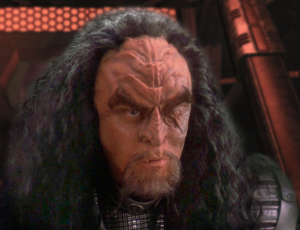
- Pages using DynamicPageList
- VisualEditor
- View history
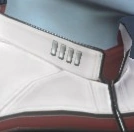
Starfleet ranks are denoted by collar pips, the 4 pips here denoted the rank of Captain
In Star Trek Online , ranks denote the level of a character or NPC. Ranks are taken from those ranks used in Star Trek which they themselves, in the case of Starfleet are derived from the U.S. Navy. Higher ranks denote more powerful NPCs and unlock new abilities and systems to the player.
- 1.1 Rewards
- 1.2 Ship Requisitions
- 2 Bridge officers
- 4 Other usage
Player characters [ | ]
New systems (e.g., Duty Officers , Crafting or Admiralty ) and various player abilities are unlocked at specific levels (see below). At each new rank, a new tier of playable starships , the next column of the skill tree, as well as a new Personal trait slot are unlocked.
In addition, a player unlocks new pips or uniform decorations that can be attached to their uniform at a Tailor .
- ↑ Jem'Hadar captains begin at level 60. NPCs and Bridge Officers use these rank names, and they appear in the rank progression reward list.
- ↑ Since Rise of Discovery, All Tier 6 ships have become Scaling ships and are now available to all players after finishing their faction's tutorial.
- ↑ The Prototype Walker Light Exploration Cruiser , Kobayashi Maru Freighter , and Tong'Duj Freighter are all Tier 4 level scaling starships
- ↑ Each subsequent specialization level after reaching level 65.
Rewards [ | ]
- ↑ 1.0 1.1 1.2 Players of each faction receive a specific set of bridge officers over the course of their respective tutorials and early storyline.
- ↑ Level 2 is awarded once 9,500 Experience Points have been earned, however in-game GUI displays an outdated lower requirement of 9,000. The same display shortfall of 500 Experience Points applies to some subsequent levels below, but not all, e.g. level 10 has no discrepancy at 33,500 Experience Points.
- Only 1 free ship , tier 5-U (vs 6 for other captains by level 60, tiers 1-5)
- Only 7 free Bridge Officers , all bound (vs 12 for other captains by level 60, 4 bound + 8 tradeable)
- Only 49 free Duty Officers , all bound (vs 51 for other captains by level 60, 39 bound + 12 tradeable)
Ship Requisitions [ | ]
At levels 10, 20, 30, 40, 50, (for Lifetime Subscription players) and 61 players receive a free Starship Requisition token. Each token can be used to buy one of the following ships:
† Only available for free from level 50 for players with a Lifetime Subscription . Otherwise available for free by using the Vice Admiral Starship Requisition Token, granted at level 61
Bridge officers [ | ]
The lowest Bridge officer rank names differ slightly from those used for players as players start from Cadet, Warrior and Citizen and are promoted past Ensign, Bekk and Uhlan in the tutorial . Likewise, Dominion players are promoted straight to Elder First.
Note that some very rare special bridge officers will always display a Starfleet/KDF rank, even for Romulan Republic players, who might thus have a BOff with the rank "Commander" (= Subcommander).
Ranks for ground and space NPCs are similar to bridge officer ranks and denote their difficulty.
- ↑ 1.0 1.1 "Captain" is used for both 4 and 5-pip ground NPCs.
Other usage [ | ]
In addition, there are other tier ranking systems in-game:
- The duty officer system is currently composed of four "commendation ranks", for each commendation category. Individual duty officers also have ranks that vary depending on quality and department.
- The holdings of the Fleet Advancement System are leveled up through different "tiers".
- The personal Reputation System also lets your character progress through six "tiers" in each reputation faction.
See also [ | ]
- Max Level Boost
- 1 Infinity Prize Pack - T6 Ship
- 3 Delta Recruitment
Navigation menu
- Mission Logs
- Chronologies
- Library Computer
Klingon Ranks (FASA)
- 1.1.1 Recruit
- 1.1.2 Enlisted Second Class
- 1.1.3 Enlisted First Class
- 1.2.1 Petty Officer Second Class
- 1.2.2 Petty Officer First Class
- 1.2.3 Chief Petty Officer
- 2.2.1 Ensign
- 2.2.2 Lieutenant junior grade
- 2.2.3 Lieutenant
- 2.3.1 Lieutenant Commander
- 2.3.2 Commander
- 2.3.3 Captain
- 2.4.1.1 Thought Admiral
- 3 Notes and References
Junior Enlisted
Recruit ( FASA 2002 )
Enlisted Second Class
Enlisted Second Class ( FASA 2002 )
Enlisted First Class
Enlisted First Class ( FASA 2002 )
Noncommissioned Officers
Petty officer second class.
Petty Officer Second Class ( FASA 2002 )
Petty Officer First Class
Petty Officer First Class ( FASA 2002 )
Chief Petty Officer
Chief Petty Officer ( FASA 2002 )
Cadet ( FASA 2002 )
Junior Officers
Ensign ( FASA 2002 )
Lieutenant junior grade
Lieutenant junior grade ( FASA 2002 )
Lieutenant ( FASA 2002 )
Field Grade Officers
Lieutenant commander.
Lieutenant Commander ( FASA 2002 )
Commander ( FASA 2002 )
Captain ( FASA 2002 )
Flag Officers
Admiral ( FASA 2002 )
Thought Admiral
A Thought Admiral is a fleet grand strategist. Though he is not in direct command of naval vessels, a Thought Admiral stands, theoretically at least, above all other naval officers in matters involving long-range planning. [1]
Notes and References
- ↑ McLimore, Guy W. Jr. , Poehlein, Greg K. , and Tepool, David F. , with Ippolito, Donna , and Huettel, Todd W. " The Klingons: Star Fleet Intelligence Manual ." Star Trek: The Role Playing Game , Supplement 2002, Second Edition. Based on original material by Ford, John M. Illustrations by Todd F. Marsh , Dana Knutson , Jeff Laubenstein , and Mitch O'Connell . FASA Corporation . 1987.
- Military Ranks
- Klingon Military
- FASA Timeline
- Privacy policy
- About Trekipedia
- Disclaimers
- Login / Create Account

- View history
In Starfleet , an enlisted crewman was one who had not completed the four-year Starfleet Academy course. Enlisted crewmen receive basic training, along with any specific courses required for their position at the Starfleet Technical Services Academy on Mars , before being posted. ( TNG : " The Drumhead ", " Eye of the Beholder "; DS9 : " Shadowplay ", " Starship Down ")
Other force structures, such as the Klingon Defense Force and the Bajoran Militia , have enlisted personnel in their ranks.
As with commissioned officers , there was a rank structure among enlisted crew. ( DS9 : " Starship Down ") The term " non-commissioned officer " refers specifically to any enlisted personnel given authority over other personnel. ( DS9 : " Hippocratic Oath ") In Starfleet, this refers to any petty officer up to master chief .
All commissioned officer ranks, from ensign upward, outrank all enlisted officers in the chain of command . ( DS9 : " Facets ", " Hippocratic Oath ") Additionally, chief petty officers , such as Miles O'Brien , wielded influence far beyond their place in the rank structure due to their extensive experience and skill and act as mentors to junior enlisted and commissioned officers. ( DS9 : " Starship Down ", " The Ship ") Enlisted personnel may be promoted to receive a commission. ( DS9 : " Once More Unto the Breach ")
- 1.1 Naval ranks
- 1.2 Ground-side and aviation ranks
- 1.3 Ratings
- 2 Background
Rank structure [ ]
Naval ranks [ ].
- Master chief petty officer
- Senior chief petty officer
- Chief petty officer
- First class
- Second class
- Third class
Ground-side and aviation ranks [ ]
- Master sergeant
- First sergeant
- Staff sergeant
- Private / Airman
Ratings [ ]
- Engineer's mate
Background [ ]
Gene Roddenberry initially envisioned a Starfleet entirely composed of officers during the creation of Star Trek: The Original Series . " Although the Enterprise is a military vessel, " he said, " its organization is only semimilitary. The 'enlisted men' category does not exist. Star Trek goes on the assumption that every man and woman aboard the USS Enterprise is the equivalent of a qualified astronaut , therefore an officer. " ( The Making of Star Trek , p. 209) In a six-page memo he sent Gene L. Coon about the first draft script of TOS : " Court Martial " (sent on 15 August 1966 , while the episode had the working title "Court Martial on Star Base 811"), Roddenberry pointed out, " There is a feeling of an officer-enlisted man arrangement in this script. Actually, we've avoided terminology or playing of 'enlisted men' aboard our vessel. Every man aboard is a trained astronaut, even the cooks . "
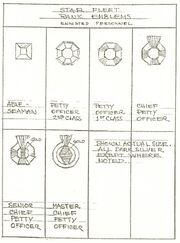
Robert Fletcher's original costume notes, page 9.
For the Star Trek films , costume designers created insignia for chiefs, petty officers, and even crewmen. In particular, Robert Fletcher 's Star Trek II: The Wrath of Khan uniforms had an entire series of enlisted rank insignia (p. 9). Some of these were reproduced (albeit incorrectly) in the Star Trek Encyclopedia . This is the origin of the "ables'man" term, which has not been used elsewhere in Star Trek . Fletcher's original costume notes actually referred to the rank of crewman as "able seaman", a term which has been used nowhere else in Star Trek .
Additionally, in Fletcher's personal notes (p. 11), he indicated that "there is no warrant rank ," however, in a later 2 June 1987 '"Star Trek" Cast Ranks' memo from Rick Berman to Bill Theiss , the intention during TNG was to have warrant ranks, whereas it was stated that the "C.W.O." (" Chief Warrant Officer") was described as having "1 Black Disk" (pip). The Star Trek Encyclopedia (4th ed., vol. 2, p. 369) labels this enlisted rank insignia as "Chief Warrant Officer".
- 1 Abdullah bin al-Hussein
- 3 John Paul Lona

Faction Reputation, and How to Get It
Carnac | August 2, 2020 June 5, 2020 | Strategy
If you’re looking to advance in Star Trek Fleet Command, finish missions, win battles and get bigger ships, you’re going to need faction reputation.
How do I get Faction Reputation?
- Killing hostiles of the other factions.
- Completing your daily goals
- Completing missions
- Spending resources in the various daily Faction Reputation Events
- Defeating armadas (the only way to gain faction rep without losing any).
- Spending charged nanoprobes in the event store.

Getting Faction Reputation from Killing Hostiles
As with most everything in Star Trek Fleet Command, it’s all about triangles. So if you kill a Federation ship, your Romulan rep will go up a lot, your Klingon rep will go up about half as much, and your Fed rep will go down. Higher-level ships will give you more reputation than lower-level ships. Survey ships will get you more reputation than warships. And scout ships not only give you messages, but they provide you with more reputation than survey ships.

Reputation Levels
Faction “lock”.
When you get your reputation with any of the factions to 10 million, it will lock, meaning that it will never fall below 10 million. No matter how many ships you kill, or missions you do, the lowest your faction rep will go will be 10 million. Dual faction lock and triple faction lock will open up a lot of ships and resources for you.
What’s the Faction Store?
Here you’ll find ship blueprints, loyalty packs, recruit packs, raw materials, avatars, and commendation ranks. You’ll spend the faction credits that you’ll earn on these. In general, you’ll want to save your faction credits for ship blueprints. The loyalty packs are good too but don’t go nuts with those.
And here’s the answer to the question that everyone has asked so far – no, you shouldn’t buy the commendation ranks until you absolutely have to for a mission . They don’t do you any good beforehand, and yes, I really wish someone had told me this before I bought a few.
I can’t imagine why anyone would spend faction credits on avatars… but to each his own.
What About the Augment Faction?
Augments are a horse of a different color. Augment reputation is earned in events, or purchased in the faction store. You can’t get it by destroying ships. It never goes down. Once you get to 10,500,000 you never have to worry about it again.
USS Saladin
T’pring – your max protect and gas officer.
- More Networks
Screen Rant
The 7 most popular klingons in star trek, according to ranker.
Ranker pollsters have voted on which Klingon characters throughout multiple series and movies are fan favorites.
With the recently launched Paramount+ offering of Star Trek: Strange New Worlds , it's a foregone conclusion we'll be seeing early Starfleet's greatest adversary at some point. While Star Trek boasts a number of recurring, non-human races in Starfleet ranks as well as adversaries for the Federation, it's the intriguing and diehard warrior race of the Klingons which has most captured Trekkers' imaginations throughout the varied series and movies.
Related: The 10 Best Star Trek Klingon Episodes
It's difficult to pinpoint the best of the best, one certain Enterprise-D chief of security notwithstanding, but Ranker pollsters gave it a fair shot.
Kruge (Star Trek III: The Search For Spock)
Trekkers inherently know that the third cinematic outing for Star Trek' s original series crew had its share of criticisms, but few of them centered on Christopher Lloyd's ruthless Commander Kruge. In seeking out the Genesis project to use as a weapon of mass destruction, Kruge managed to do what few former Klingon adversaries did not to one Captain James Tiberius Kirk. He hurt him but good, not only forcing Kirk to use the self destruct mechanism to destroy the original Enterprise, but also ordering the death of Kirk's son David to prove his resolve. Lloyd delivered in a tongue-in-cheek yet intensely foreboding performance as a determined and unmerciful Klingon commander.
Kang (Star Trek: The Original Series)
Kang began his long and illustrious Klingon career as an adversary for Captain Kirk in the original series. It was later retconned by Trek writers that he was in fact a product of 22nd century genetic engineering, descended from Klingons affected by an augment virus as seen in the Enterprise episode Divergence, a method in which screenwriters used to explain away the stark change in Klingon appearances from the original series into The Next Generation series.
Related: 10 Times Spock Made A Joke And You Missed It
He was later cured of the affliction as seen in the Flashback episode of Star Trek: Voyager. Kang also knew Curzon Dax, as recalled by Jahdzia Dax in Star Trek: Deep Space 9 . Michael Ansara gives a nuanced performance as the debut example of Trek's warrior caste.
Gowron (Star Trek: The Next Generation)
Played to an utterly intense level by the always reliable Robert O'Reilly, the Chancellor of the Klingon High Council has been a frequent adversary and reluctant ally for many of Star Trek' s most prominent officers, most notably to Commander Worf as well as Captain Picard, Captain Sisko, and General Martok. His ascension to the Klingon High Command resulted in many seminal Trek moments including Worf's reversal of family disgrace to the House of Mogh at the outset of the Klingon civil war and one of the best Trek battles scenes ever put to tape in the assault of the Klingon fleet on Deep Space 9 during the Federation-Klingon war. Gowron was perhaps the most ominously portrayed Klingon in all of Star Trek history.
Kurn (Star Trek: The Next Generation)
Worf's young brother Kurn, as portrayed by the great Tony Todd of many a horror franchise (most notably in the Candyman series), established himself from the onset as a formidable Klingon presence both in Star Trek: The Next Generation and Star Trek: Deep Space 9. First coming aboard the Enterprise-D to assess Worf's loyalties, he became his older brother's staunch ally, first during Worf's necessary discommendation to avoid a Klingon civil war and again during Gowron's ascendancy and the subsequent return of honor to their house.
Related: 10 Best Shows Like Star Trek: Strange New Worlds
Todd's rendition of a powerful Klingon dedicated to his sworn oaths as a Klingon warrior and brother to Worf was fierce and a welcome addition to Trek's supporting cast.
Kor (Star Trek: The Original Series)
Kor has been a fan fave since the early days of the original series. Like Kang, he too was a (retconned) descendant of the Klingon augment virus, and holds the distinction of being Star Trek 's very first Klingon antagonist and a frequent detractor of the Romulan empire . Played by the science fiction staple actor John Colicos, well known for his Battlestar Galactica role as well as recurring Trek figure Kor, Colicos brought a menacing if smarmy attitude to Kirk's first warrior adversary. Later in the franchise, Kor was revisited as a more wizened yet still passionate Dahar Master warrior and appeared in a trio of Deep Space 9 episodes as an older officer losing his senses of reality, ultimately sacrificing himself nobly in the Dominion War.
Martok (Star Trek: Deep Space 9)
The one-eyed general of formidable stance became a stalwart and honorable ally to Captain Sisko and the Deep Space 9 crew, thanks to two significant components of the character: his admiration of Commander Worf, eventually inviting him to join his family house, and the stellar portrayal of the grizzled Klingon war veteran by character actor J.G. Hertzler.
Related: The 10 Best Star Trek Vulcan Episodes
Martok became a integral part of the multi-season Dominion War story arc, undergoing a number of changes including at one point being replaced by a changeling. It was Martok's dedication to honor above all else that set him apart as a truly worthy Klingon warrior bereft of ambition or failure of duty.
Worf (Star Trek: The Next Generation)
A consistently outstanding performance from Michael Dorn makes the Enterprise's chief of security a powerful yet sympathetic character within both the TNG and the DS9 series. Worf's upbringing by his Russian foster parents was a frequent aspect of Worf-centric episodes, with his Klingon warrior side often at odds with his Starfleet officer side. Dorn's Klingon is one of Star Trek 's most popular characters of all time and fans are eagerly anticipating his return in season three of Star Trek: Picard.
Next: The 10 Best Star Trek Novels According To Goodreads
- Klingon Ranks
If you are granted permission to play a Klingon officer, please refer to the table below to guide you.
A previously-played Klingon ship was the IKV Dreamslayer . On this ship, ranks were displayed in the character's profile in Klingonese .
Though the Klingons are no longer a playable faction on Federation Space, historically players were capped at Lieutenant .
- Klingon Empire
- Intelligence
Navigation menu
Personal tools.
- View source
- View history
- Administration
- Historical Archives
Star Fleet Resources
- Corps of Engineers
- Office of Intelligence
- Medical Command
- Applied Sciences
- Security Command
- Elite Joint Operations
- Tactical Command
Additional Tools
- Recent changes
- Random page
- What links here
- Related changes
- Special pages
- Printable version
- Permanent link
- Page information
- Cite this page
- This page was last edited on 18 November 2022, at 18:16.
- Privacy policy
- About Federation Space - Official Wiki
- Disclaimers
- Mobile view
Klingon Defense Force Ranks
The ranks of the Klingon Defense Force were codified by the Klingon High Command, derived from military titles and ranks of lore and tradition. The militaries of the Great Houses share the rank system, the holders expected to bear equal prestige and authority. This allows for easy cohesion of all Klingon military forces should the KDF gather the Deep Space Fleet.
- 1 Flag Ranks
- 2 Officer Ranks
- 3 Warrior Ranks
Officer Ranks
Warrior ranks.
Credit for Starfleet officer ranks goes to Bravo Fleet. Credit for Starfleet enlisted and all Klingon ranks goes to Kuro of Kuro-RPG .
- Bravo Fleet Canon
- Klingon Empire

Main Page | About | Help | FAQ | Create account | Log in
- Command Staff
- Fleet History & Map
- Mission Statement
- Sim Listings
- Open Positions Search
- Fleet Documents
- Ship Specifications
- Fleet Awards
- JAG Case Archives
- Player Application
- CO Application
- Sim Application
- Instructor App
- Hosting Application
- Star Trek Canon
- Pegasus Fleet Official Policies
Klingon Defence Force Ranks
The rank system of the Klingon Defence Force bears some resemblance to various Earth ranking systems. A ceremonial sash of varying design and material is worn by commanding Klingon warriors to show rank and status in society. The sash can be made of many materials, most commonly of gold thread or silver metal. On the upper section of the sash is an emblem of their House affiliation and various other decorations.
Klingon warriors wear a circular pip with a unique design contained within on the right side of their neck in order to display their rank on the uniforms of the Klingon Defence Forces. The left side displayed a similar pip with the specific branch of the Defence Forces the individual belonged to - Navy or Ground Forces. These pips are worn on the tube-like collar of the uniforms. However, the command structure of the KDF is rather blurred when compared with Starfleet's, as Klingon Generals - such as Martok - were capable of commanding both naval and ground forces simultaneously.
Enlisted ranks in the Klingon Defence Forces share the same nomenclature, but still display separate insignias dependant upon the warrior's branch of service.
Current Rank Charts
Klingon ranks have changed and evolved little over time, though the method of displaying them often has. Below are the most current rank insignias in use by the Klingon Defence Forces, displaying where possible both the original Klingon and the Federation Basic translation.
Navigation menu
- Fleet Homepage
- Fleet Forum
- Recent changes
- Random page
- Page Templates
fleet structure
- Task Forces
- Member Starships
- Member Starbases
fleet documents
- Constitution
- Standing Orders
- Executive Orders
wiki portals
- Society & Culture
- Simulations
- Simming Positions
- Crew Application
- Command Application
- What links here
- Related changes
- Special pages
- Printable version
- Permanent link
- Page information
- More to Explore
- Series & Movies
Published Apr 10, 2024
The Best Star Trek Siblings
Best friends and/or bitter rivals, here are some best groups of siblings from throughout the Star Trek universe.
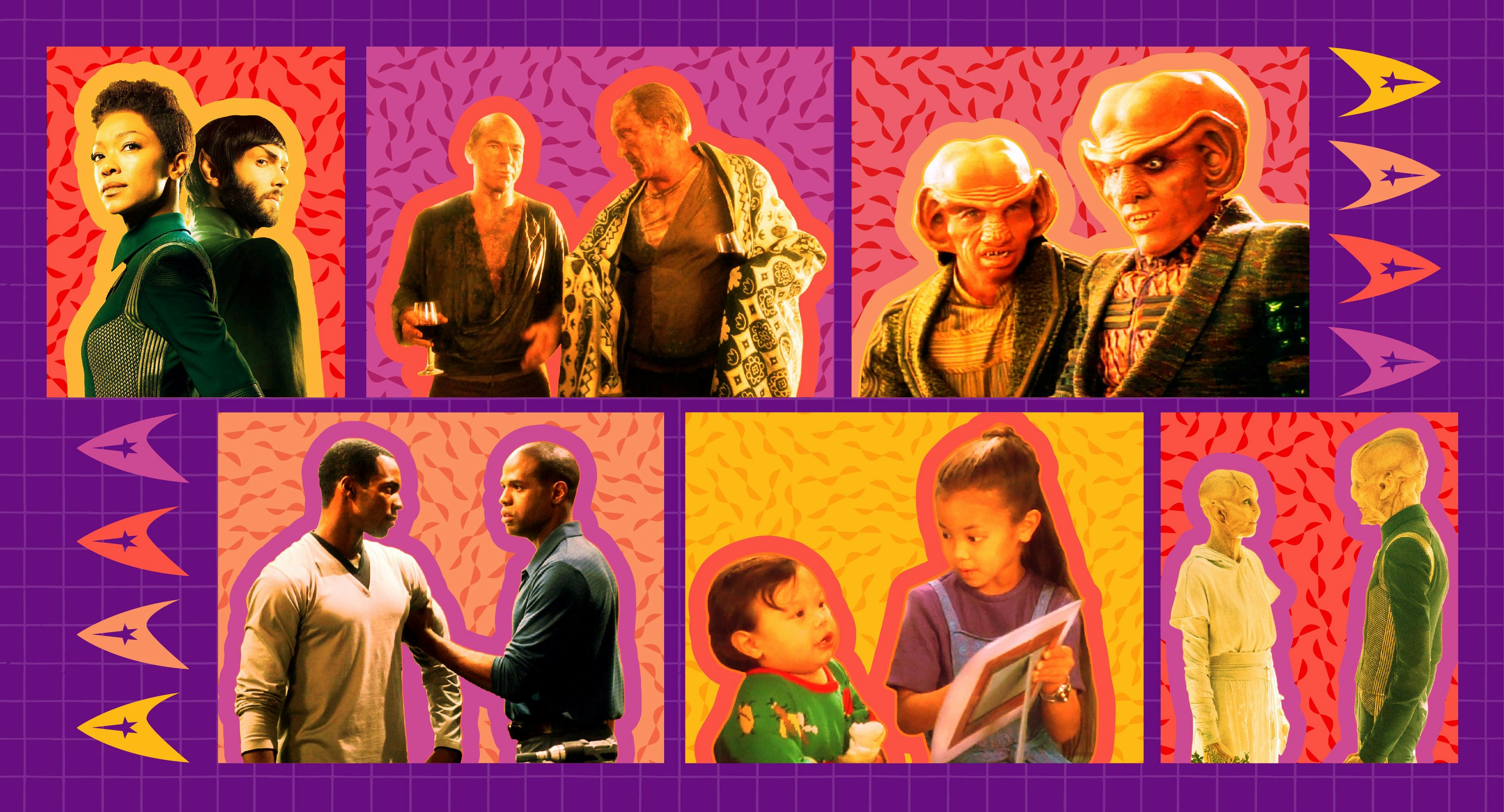
StarTrek.com
The Star Trek universe is full of siblings. Sometimes they are the best of friends. Sometimes they are bitter rivals. But, regardless of the tenor of their relationship, each familial clan still thrives and stands out through the rich storytelling the franchise serves up.
The rules for this list are as follows — they have to have appeared on-screen (not merely mentioned) and be identified as a sibling, no matter if that means biological, adopted, foster, or chosen. Additionally, siblings connected through different familial relationships are kept separate.
In celebration of Siblings Day, here are the a handful of the best sets or groups of siblings from throughout the entire franchise.
22. Wesley and Jack Crusher
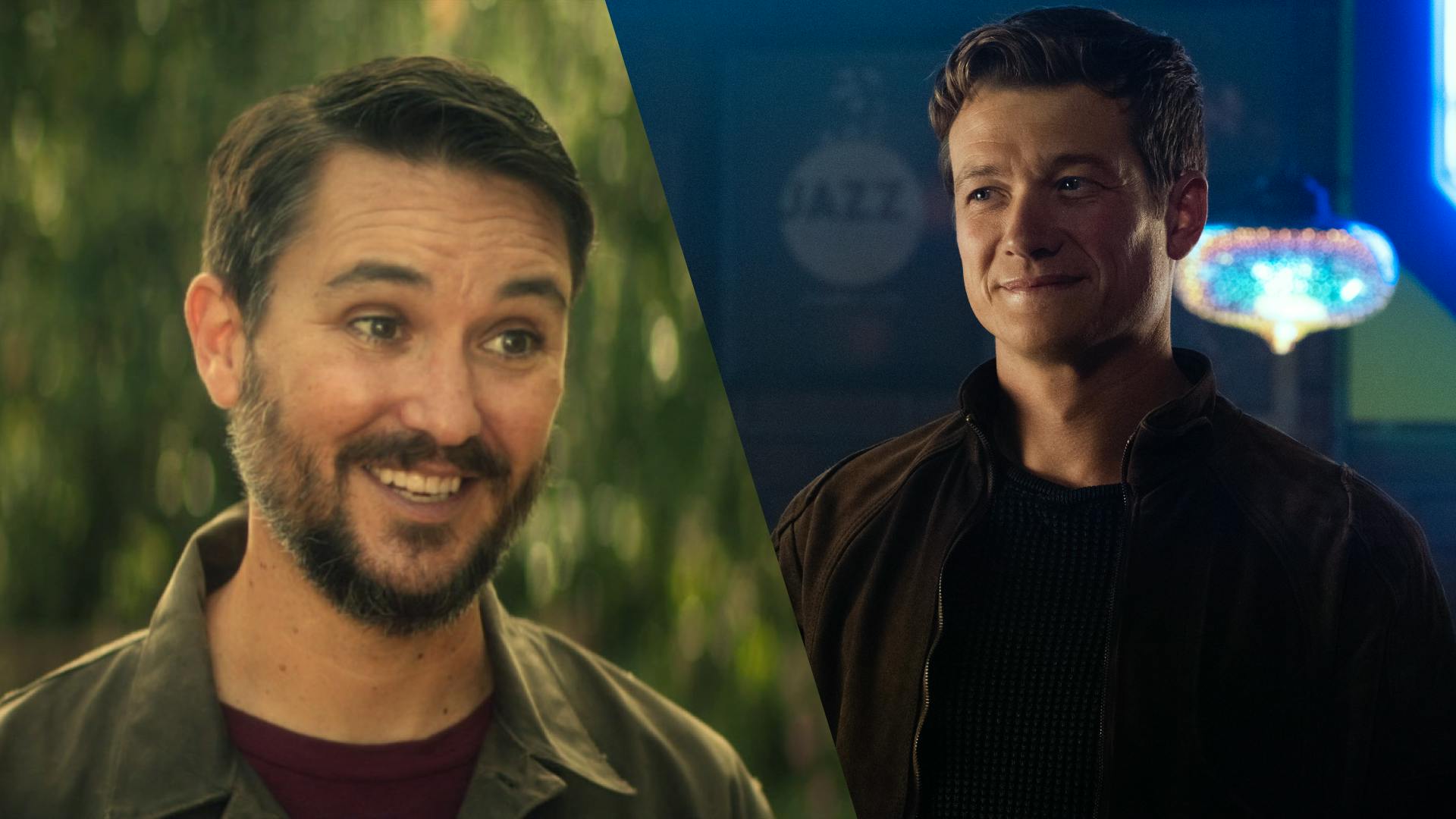
Dr. Beverly Crusher bore two incredible gifted sons — Wesley Crusher (son of Jack R. Crusher) and Jack Crusher (son of Jean-Luc Picard). Despite being decades apart in age, we're certain Wesley's journey as The Traveler allowed him to watch over his mother and half-brother from afar.
Losing her husband, the elder Jack, and Wesley to the stars made Beverly more protective of her youngest child, hiding him away from all of Jean-Luc's enemies and Jean-Luc himself.
21. D'Vana and D'Erika Tendi
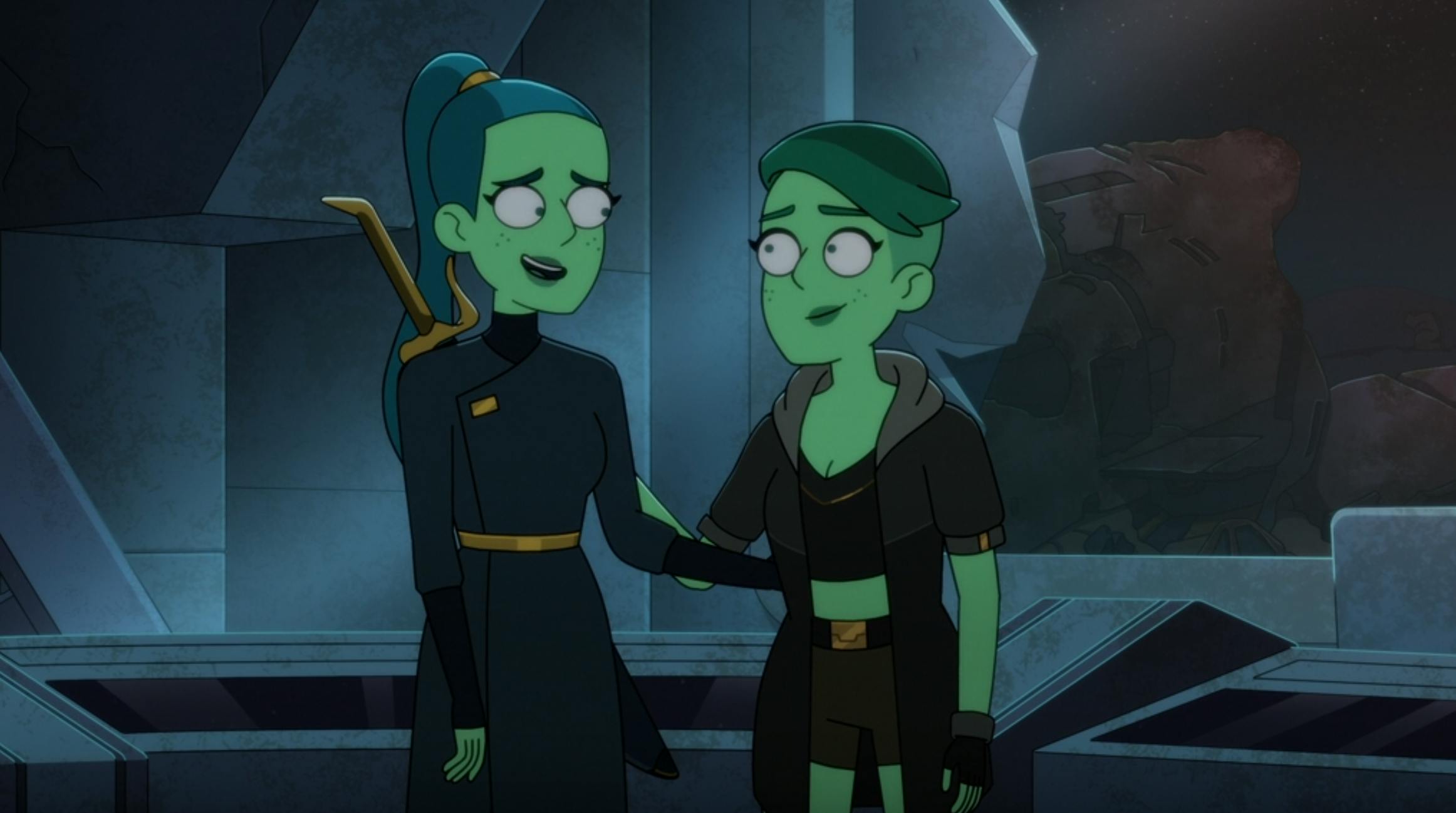
"Something Borrowed, Something Green"
The daughters of B'Rt and Shona Tendi, one of the fifth largest families in the Orion Crime Syndicate, grew up very close. However, D'Vana would crave more out of life other than piracy. Pursuing her love of science and space, D'Vana would leave the family trade and her role as the Prime for a career in Starfleet.
D'Erika would see this abandonment as a betrayal as it forced her to take on the role as the family's prime assassin and live in the shadow of her sister's Mistress of the Winter Constellations legacy. The two sisters would reconcile when D'Vana returned home to Orion following news that her sister was kidnapped ahead of her nuptials. In later negotiations to save her best friend Beckett Mariner and provide the Cerritos with an Orion warship, D'Vana negotiates an offer D'Erika cannot refuse — her return to Orion, reuniting the sisters once more.
20. Worf and Nikolai Rozhenko

"Homeward"
The son of Worf’s foster parents, Nikolai Rozhenko, and Worf didn’t get along as children, though they respected each other’s strong wills and personalities. Their paths crossed as adults when Worf was assigned to prevent his foster brother from further violating the Prime Directive as he observed a race known as the Boraalans.
19. Cleveland Booker and Kyheem

"Sanctuary"
Though not biologically related, Cleveland Booker and Kyheem referred to each other as brothers. Raised together, Kyheem felt Booker was a coward who abandoned their family. They shared the same empathic abilities and worked together to drive the Emerald Chain’s swarms of locusts to the ocean, healing their rift in the process.
18. Tasha and Ishara Yar
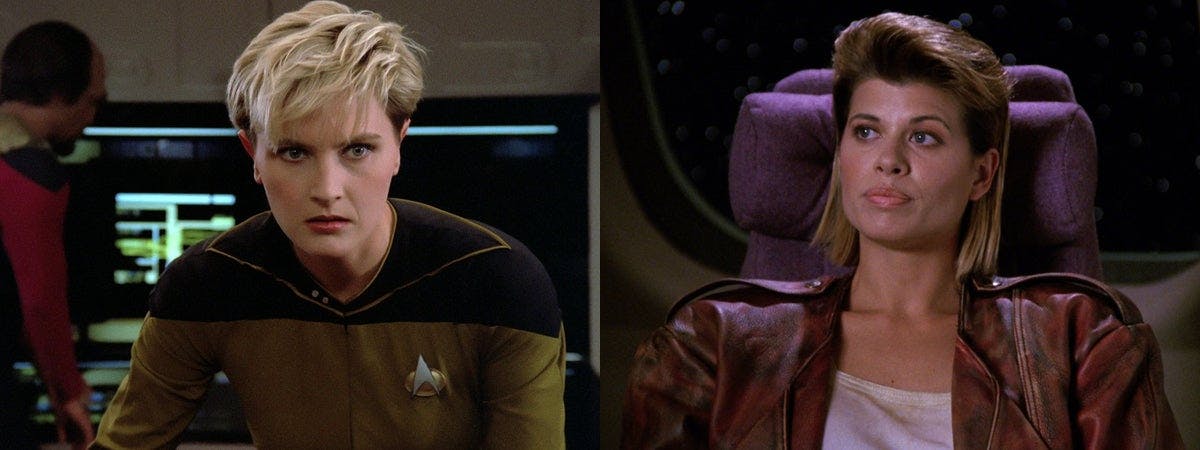
Tasha Yar essentially raised her younger sister Ishara on the torturous colony Turkana IV. The two sisters parted ways as young teenagers when Tasha escaped their homeworld and joined Starfleet. They never saw each other again; Ishara resented her sister.
Years later, Ishara used her relationship to Tasha to manipulate the crew of Enterprise into helping her commit an act of terrorism.
17. Kestra and Deanna Troi
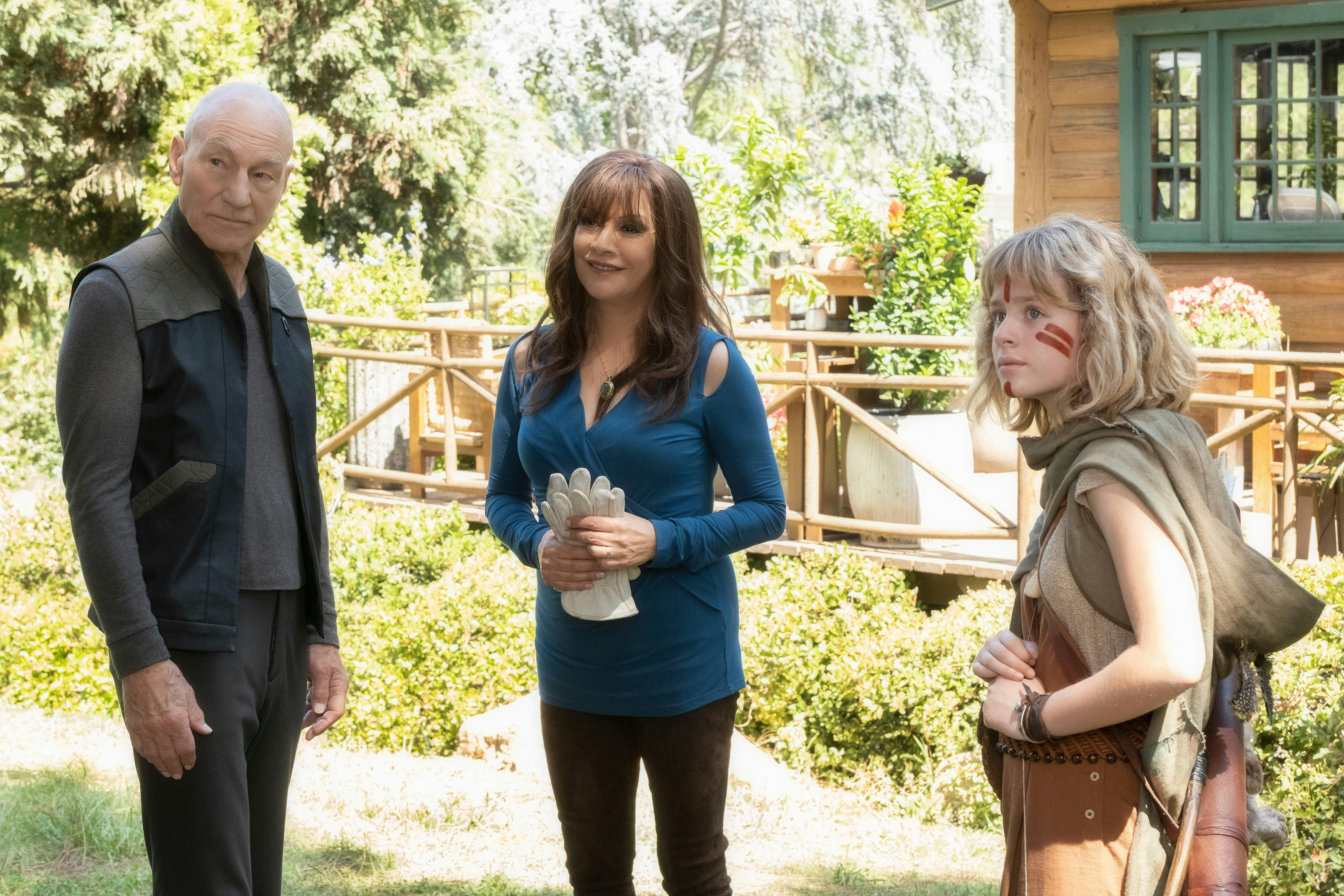
"Nepenthe"
The firstborn child of Ian and Lwaxana Troi, Kestra Troi died in a tragic accident when she was six years old, shortly after the birth of her younger sister Deanna. Deanna learned of her late sister while helping her mother through a traumatic telepathic episode on the Enterprise .
Some years later, Deanna would go on to name her first daughter Kestra after her sister.
16. Narek and Narissa
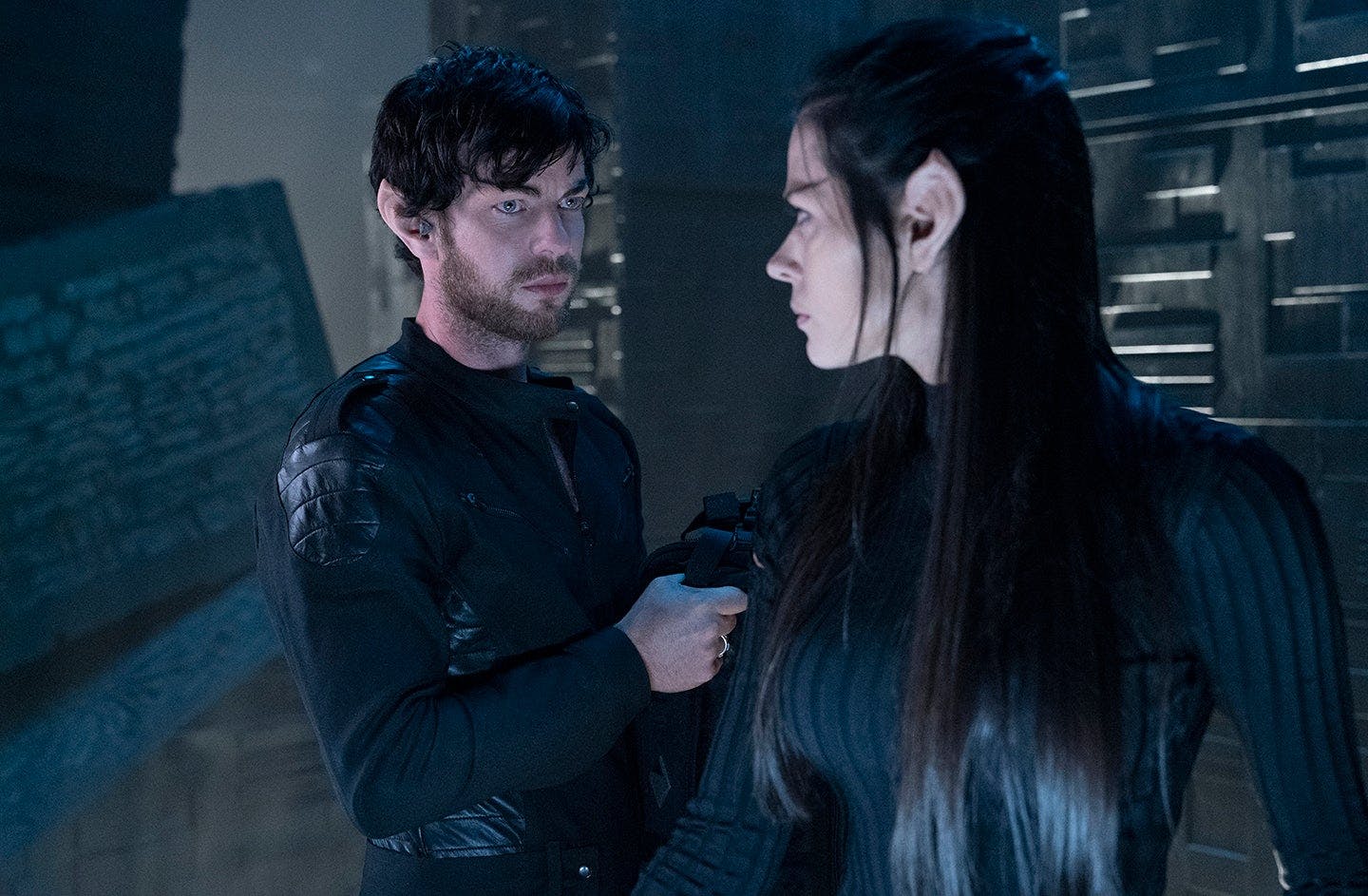
"Et in Arcadia Ego, Part 1"
Two of the children of members of the mysterious Romulan cabal known as the Zhat Vash, Narek and Narissa were committed to the group's efforts of annihilating all artificial life in the galaxy. They worked together in this effort, though distrusted each other and frequently questioned and criticized each other’s methods. Narek often felt inferior to Narissa as he believed she judged him as the family's "Zhat Vash washout."
15. Ezri, Norvo, and Janel Tigan
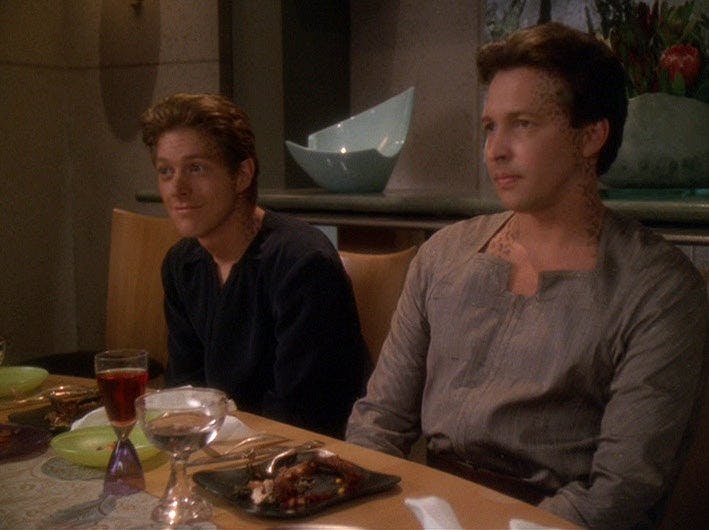
"Prodigal Daughter"
Before she was Ezri Dax, she was Ezri Tigan, the middle child between two brothers, Norvo and Janel. Though there was tension in their family, Ezri was particularly close to her brother Norvo who she believed had several artistic gifts. The three siblings went their separate ways after Ezri learned Norvo had murdered a woman and Janel was involved with the Orion Syndicate.
14. Paul and Travis Mayweather
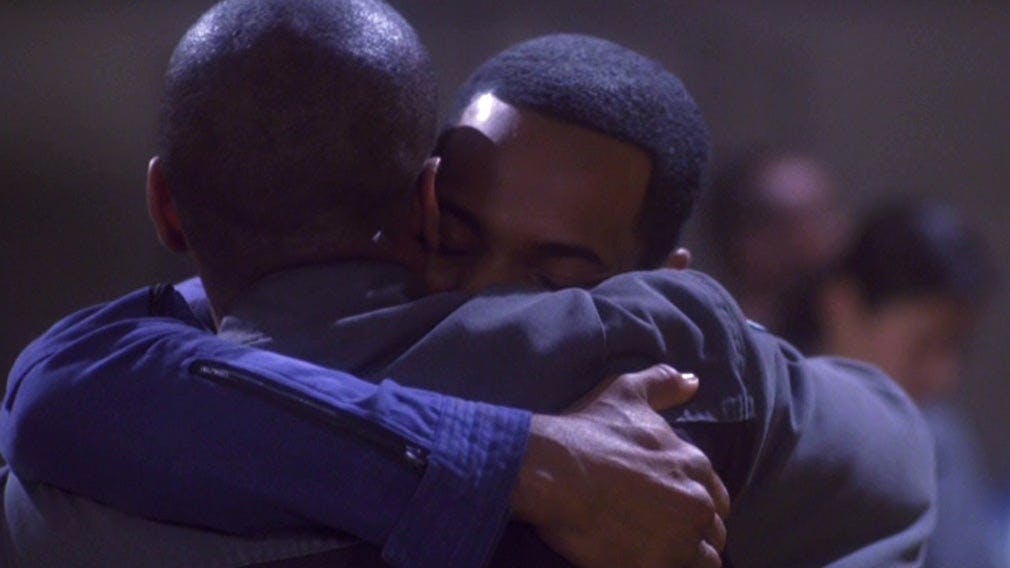
"Horizon"
Like many brothers, a stiff sibling rivalry existed between Travis Mayweather and his younger brother Paul. Paul resented Travis for leaving their family’s cargo ship the Horizon to join Starfleet.
When the two brothers reunited during Travis' visit "home" to the ship, Travis used his Starfleet training to upgrade the Horizon 's system, further irritating, but also helping Paul, and allowing a bit of a détente between them.
13. Kor, Curzon, and Jadzia Dax
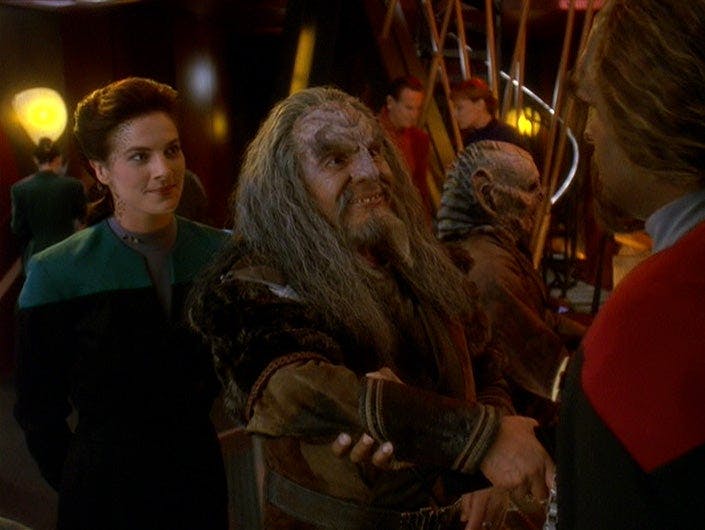
"The Sword of Kahless"
Having first met during the peace negotiations between The United Federation of Planets and the Klingon Empire, Klingon warrior Kor and Trill Curzon Dax formed a close bond through adventurous escapades together, referring to each other as a blood brother.
When the Dax symbiont was passed from Curzon to Jadzia, Kor continued their familial relationship, going on more adventures with his blood sister.
12. Spock and Sybok
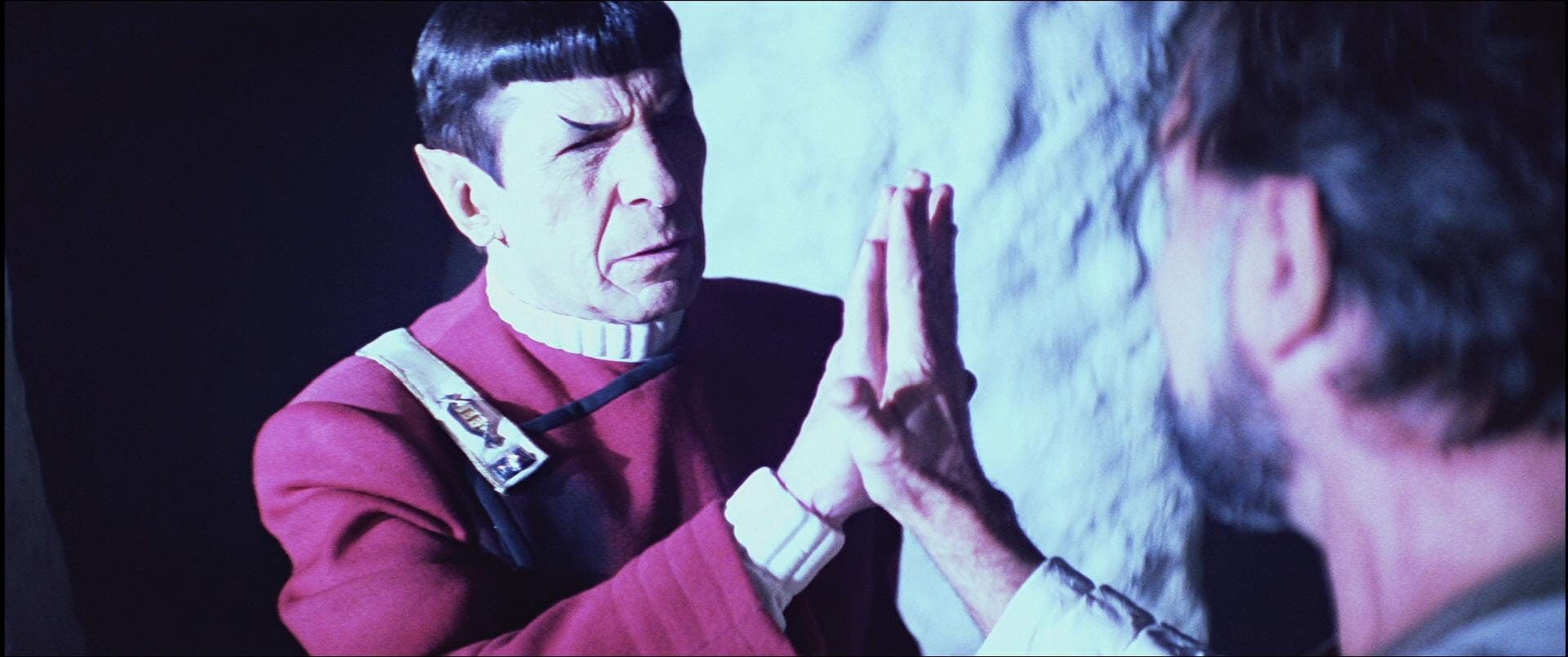
Star Trek V: The Final Frontier
The two sons of the Vulcan Sarek, Spock and Sybok travelled very different paths. Although half human, Spock embraced the logical traditions of his people, while his older brother Sybok, a full Vulcan, rejected them, instead embracing emotions.
Estranged for decades, the brothers reunited and reconciled after a fashion when Sybok hijacked the Enterprise as part of his quest to find the Edenic Sha-Ka-Ree in the center of the galaxy.
11. Worf and Martok
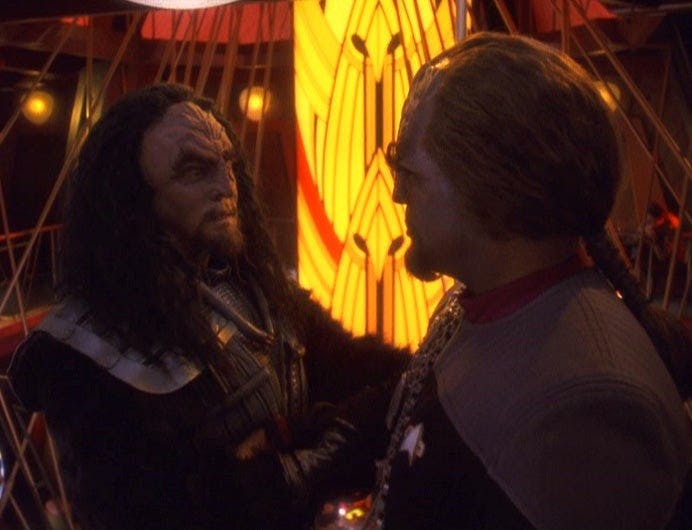
"Soldiers of the Empire"
Worf and Klingon General Martok first encountered each other in a Dominion prison camp. They helped each other survive and subsequently fought side-by-side in the Dominion War.
After Worf helped Martok rediscover his honor and courage, the General welcomed Worf into his House as a brother. The two were almost inseparable after that, supporting each other with honor through the trials of their lives.
10. Dahj and Soji (and their Coppelia siblings)
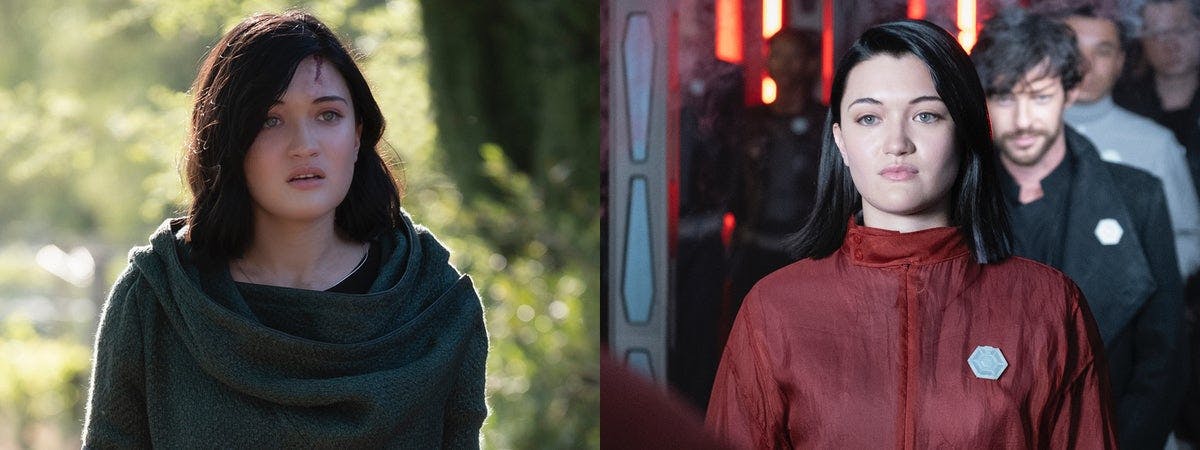
Created from a single positronic neuron by Dr. Bruce Maddox and Dr. Altan Soong through a process called fractal neuronic cloning, Dahj and Soji were twins who appeared to be fully human. The women each separately encountered Jean-Luc Picard. Though Dahj was killed, Soji relied on Picard to save her home world, Coppelia, where dozens of other synthetic twins who had been created from Data’s neural network also lived.
9. Molly and Yoshi O’Brien
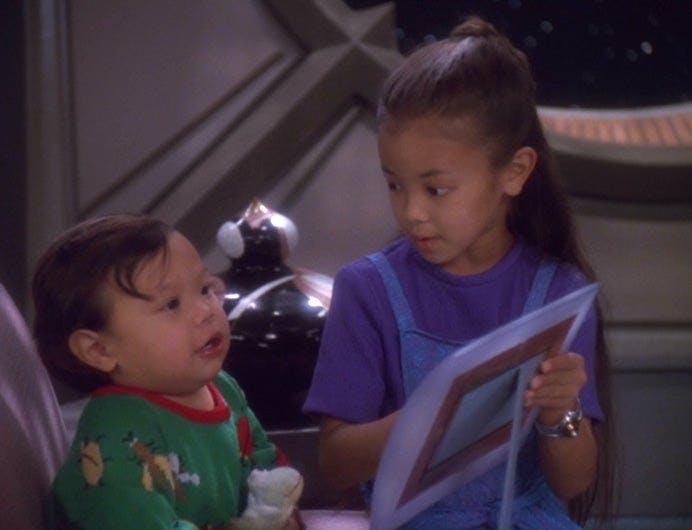
"Time's Orphan"
The children of the man considered by many to be the most important officer in Starfleet history, Molly and Kirayoshi O’Brien were both born under unique circumstances. Molly was born when the Enterprise was struck by a quantum filament, disabling the ship. While pregnant with Yoshi, Keiko O’Brien was injured on a mission, necessitating her son’s transfer into Kira Nerys’ womb, who carried him to term. Molly doted on Yoshi, and their bond was shown to be strong.
8. Saru and Siranna
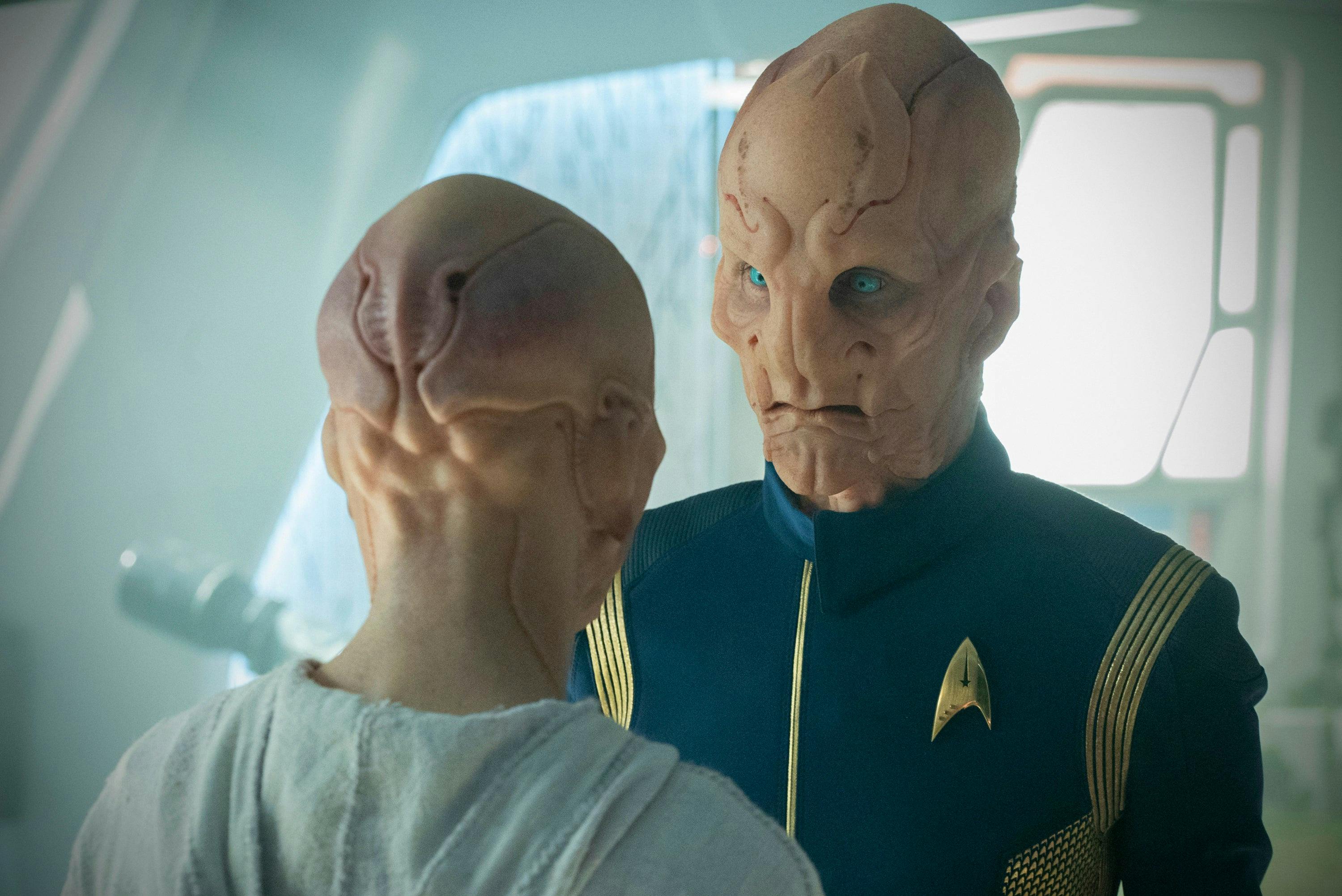
"The Sound of Thunder"
Kelpiens Saru and Siranna were devoted to each other from childhood through adulthood. Though they parted ways when Saru left Kelpinar to join Starfleet, their hearts were permanently linked.
When Saru returned to his homeworld, he helped Siranna lead their people in breaking free of their fearful natures. Siranna, in turn, came to Saru and the Discovery 's aid when it battled the sentient computer Control.
7. Worf and Kurn
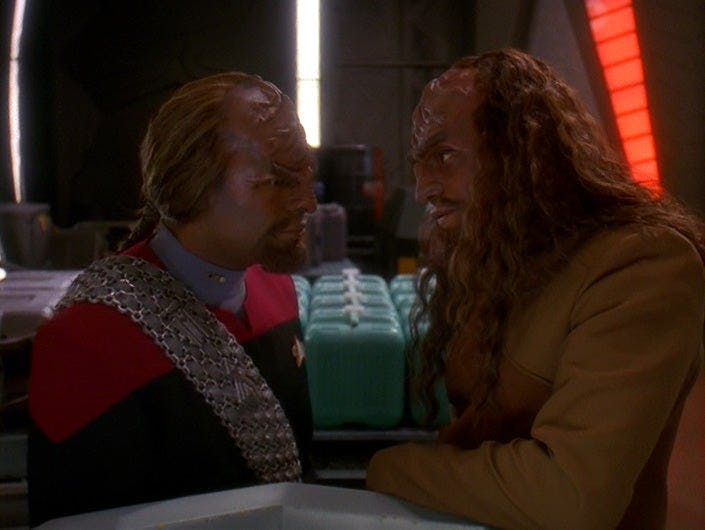
"Sons of Mogh"
Worf and Kurn, the Sons of Mogh, were separated for most of their lives following the attack that killed their parents. Kurn sought out Worf, revealing their relationship during an officer exchange aboard the Enterprise . Kurn was loyal to his brother and their family, but hid his heritage during his brother’s discommendation.
During the Dominion War, Kurn also faced dishonor. Worf helped Kurn assume a new identity to regain honor in the empire.
6. The Duras Sisters
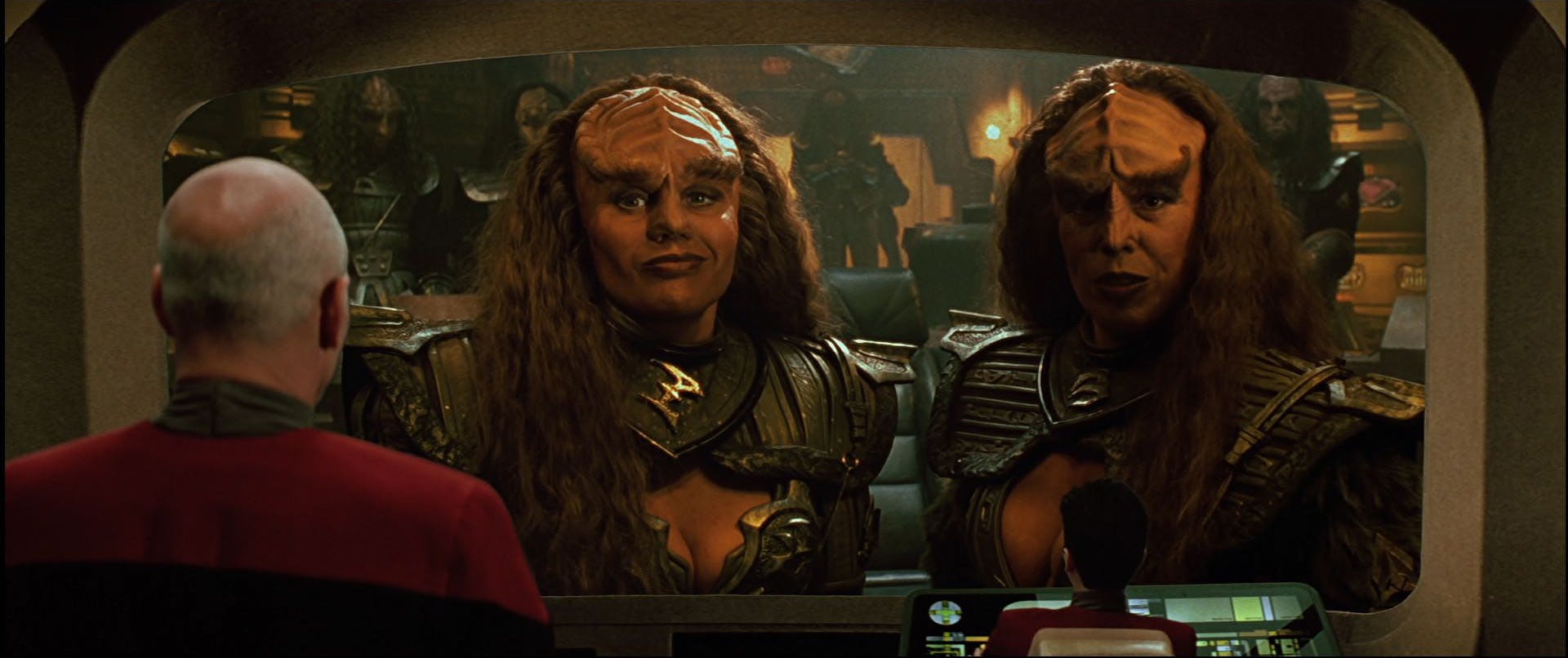
Star Trek Generations
[ RELATED : Dynamic Duos: Lursa and B'Etor Duras ]
Lursa and B’Etor were the devious sisters of Duras. Their family held great honor within the Klingon Empire until the treachery of their father Ja’rod and brother Duras came to light as well as their own conspiring with the Romulan Sela. They had successfully instigated a Klingon civil war and were responsible for the destruction of the Enterprise before dying in the same battle.
5. Jim and Sam Kirk

"Lost in Translation"
Growing up in Iowa, both James Tiberius Kirk and his brother George Samuel "Sam" Kirk saw their futures in the stars. Jim, of course, became one of the greatest starship captains in Starfleet history. Sam became a celebrated scientist.
Long before James would take command of the Enterprise , Sam Kirk served aboard the flagship under Captain Pike as his younger brother was rising the ranks aboard the Farragut. While their relationship often had hurdles, as Sam felt their father favored Jim's career, specifically achieving the title of youngest first officer in all of Starfleet, as it modeled his own career while the elder brother pursued a path in sciences. No matter the timeline, there was never shortage of love, support, and old-fashioned sibling ribbing.
4. Michael Burnham and Spock
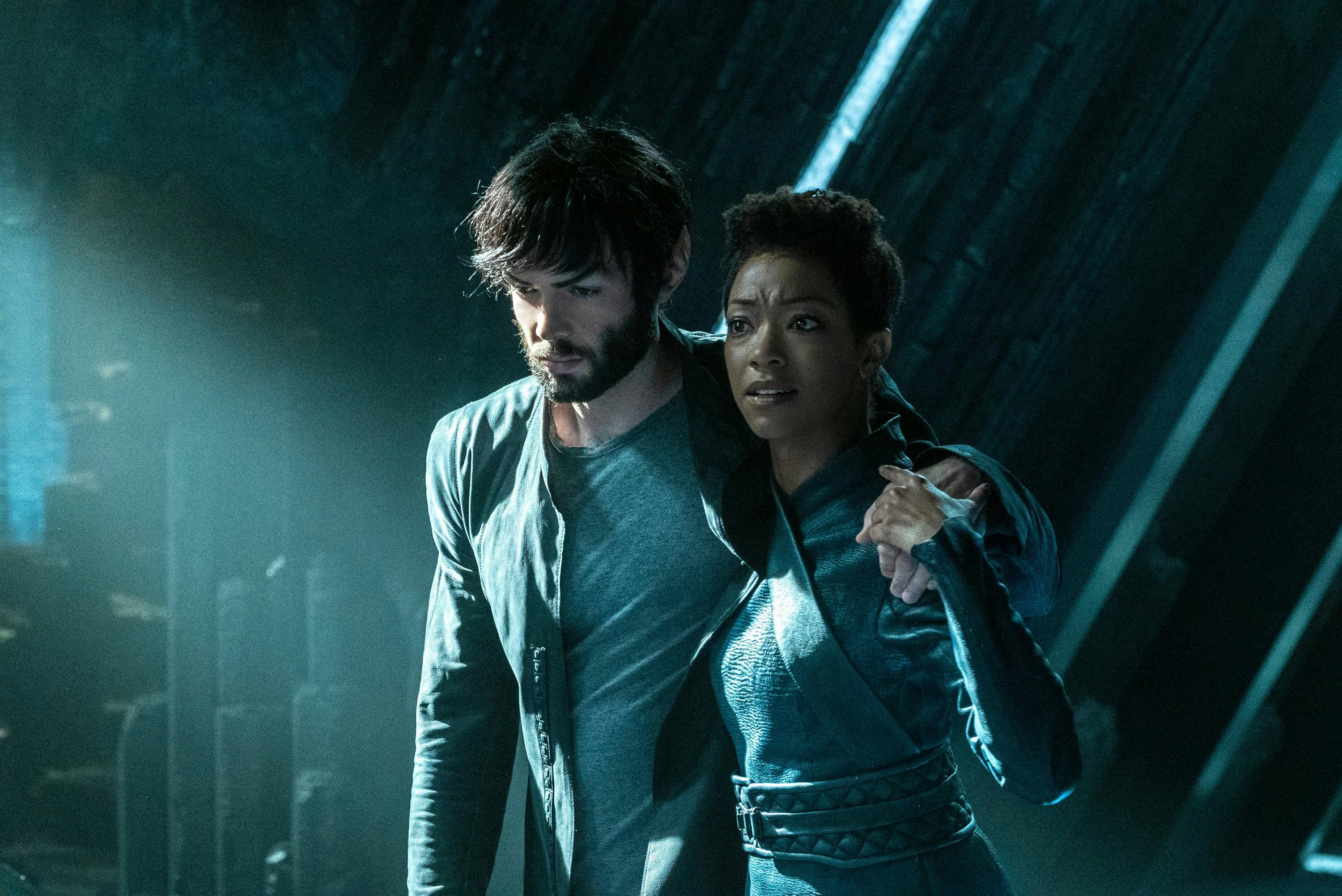
"If Memory Serves"
Having been rescued by the Vulcan Sarek and his human wife Amanda Grayson, Michael Burnham was raised alongside Sarek and Amanda's son Spock. The foster siblings faced a strained relationship at times, but when Michael was missing, Spock searched for her with the help of the Red Angel.
Michael returned the favor years later, leading the search for Spock when he disappeared and was accused of murder. Spock credited Michael with helping him become the man he did, and Michael was moved and proud when she travelled to the future and learned of Spock's legendary life.
3. Quark and Rom
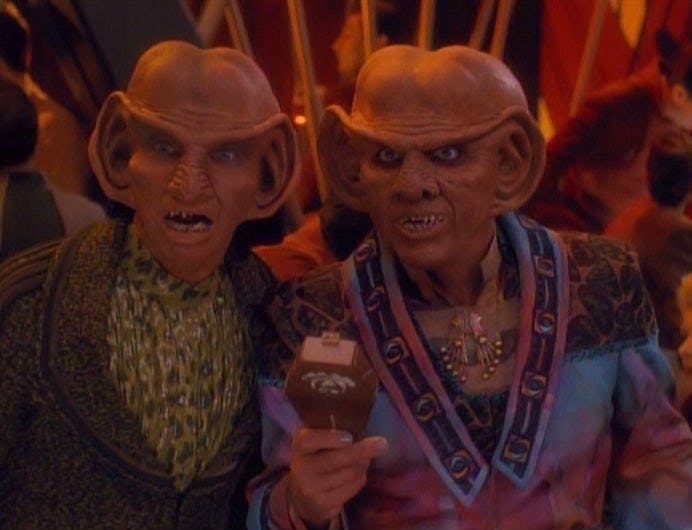
"Family Business"
On the surface, it appeared that Quark and Rom didn’t like each other very much, but the truth was few brothers loved each other as much as this Ferengi pair did. Quark often berated and manipulated Rom, but Rom always stood by his brother in his times of need. Quark also unfailingly helped his brother during crises, even breaking him out of a holding cell to prevent his execution by the Dominion. When Quark learned Rom was being named Grand Nagus, he was initially jealous but also expressed how much he truly loved his brother.
2. Jean-Luc and Robert Picard
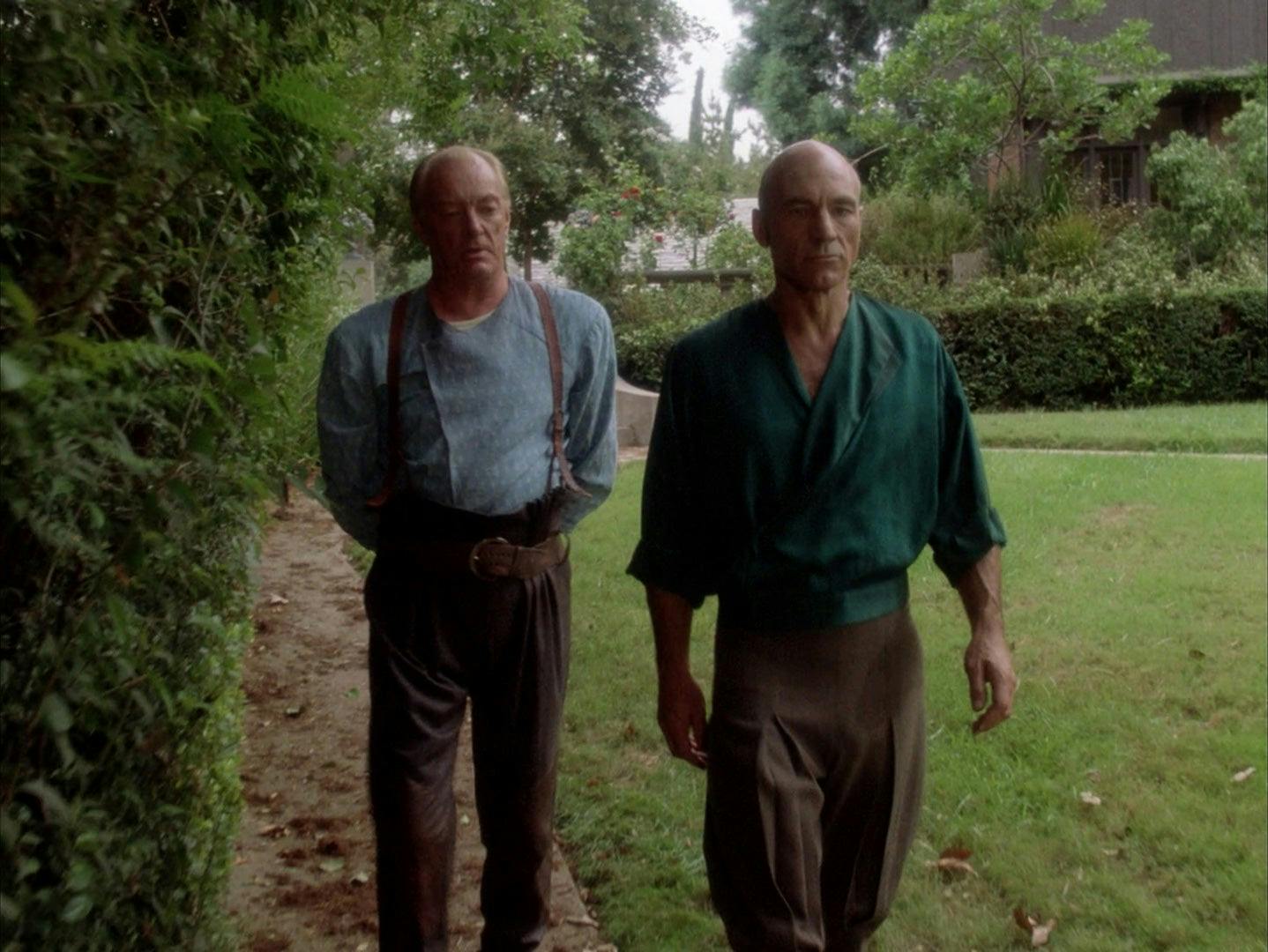
"Family"
As boys, Robert and Jean-Luc Picard bickered and battled constantly. The older brother, Robert, enjoyed bullying Jean-Luc. It wasn’t until Jean-Luc's return to the family vineyard following his assimilation by the Borg and subsequent rescue that the two brothers settled their decades-long rivalry.
Four years later, Jean-Luc was devastated to learn Robert and Robert’s son René had been killed in a fire at the vineyard.
1. The Soong Androids and Altan Inigo Soong
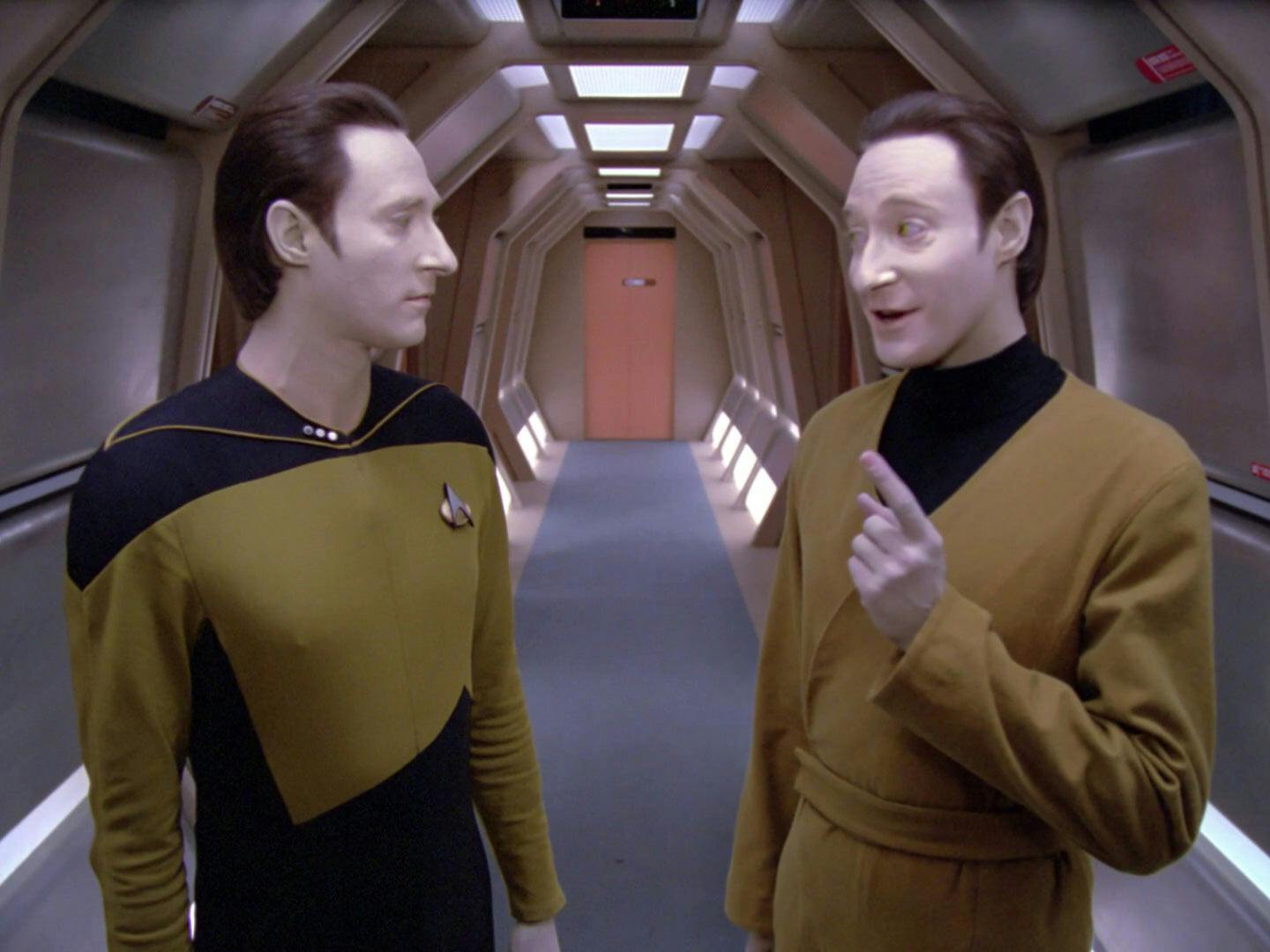
"Datalore"
[ RELATED : Android Ancestry: Examining the Soong-Type Line ]
Dr. Noonien Soong had a large family. Of his four sons, three were androids and one was human. The androids Data, Lore, and B-4 had challenging and complex relationships with each other. Data long believed he was inferior to Lore while Lore was jealous of their father’s pride in Data. Meanwhile, B-4 was used to lure Data and Picard into a Romulan trap. Data tried helping B-4 improve, but his programming was insufficient, despite Data giving B-4 his memory engrams.
Their human brother, Dr. Altan Inigo Soong, helped use some of those engrams to reconstitute Data in a simulation after the android’s death as well as using them to create numerous new pairs of synthetic twins. Altogether, they were, as Data described them, "An acquired taste." Most siblings are.
Get Updates By Email
This article was originally published on April 9, 2021.
Jake Black is a writer whose credits include Star Trek: Starfleet Logbook, Star Trek Magazine, and works for DC Comics, Marvel, WWE, Teenage Mutant Ninja Turtles, Supergirl, and many more. An eleven-year cancer survivor, he lives in a quiet Connecticut town with his wife, son, and twin daughters. Found online @jakeboyslim
Star Trek: Discovery Seasons 1-4 are streaming exclusively on Paramount+ in the U.S., the UK, Canada, Switzerland, South Korea, Latin America, Germany, France, Italy, Australia and Austria. Seasons 2 and 3 also are available on the Pluto TV “Star Trek” channel in Switzerland, Germany and Austria. The series streams on Super Drama in Japan, TVNZ in New Zealand, and SkyShowtime in Spain, Portugal, Poland, The Nordics, The Netherlands, and Central and Eastern Europe and also airs on Cosmote TV in Greece. The series is distributed by Paramount Global Content Distribution.
In addition to streaming on Paramount+ , Star Trek: Picard also streams on Prime Video outside of the U.S. and Canada, and in Canada can be seen on Bell Media's CTV Sci-Fi Channel and streams on Crave. Star Trek: Picard is distributed by Paramount Global Content Distribution.
Star Trek: Lower Decks streams exclusively on Paramount+ in the U.S. and is distributed by Paramount Global Content Distribution. In Canada, it airs on Bell Media’s CTV Sci-Fi Channel. The series will also be available to stream on Paramount+ in the UK, Canada, Latin America, Australia, Italy, France, the Caribbean, Germany, Austria, Switzerland, Ireland and South Korea.
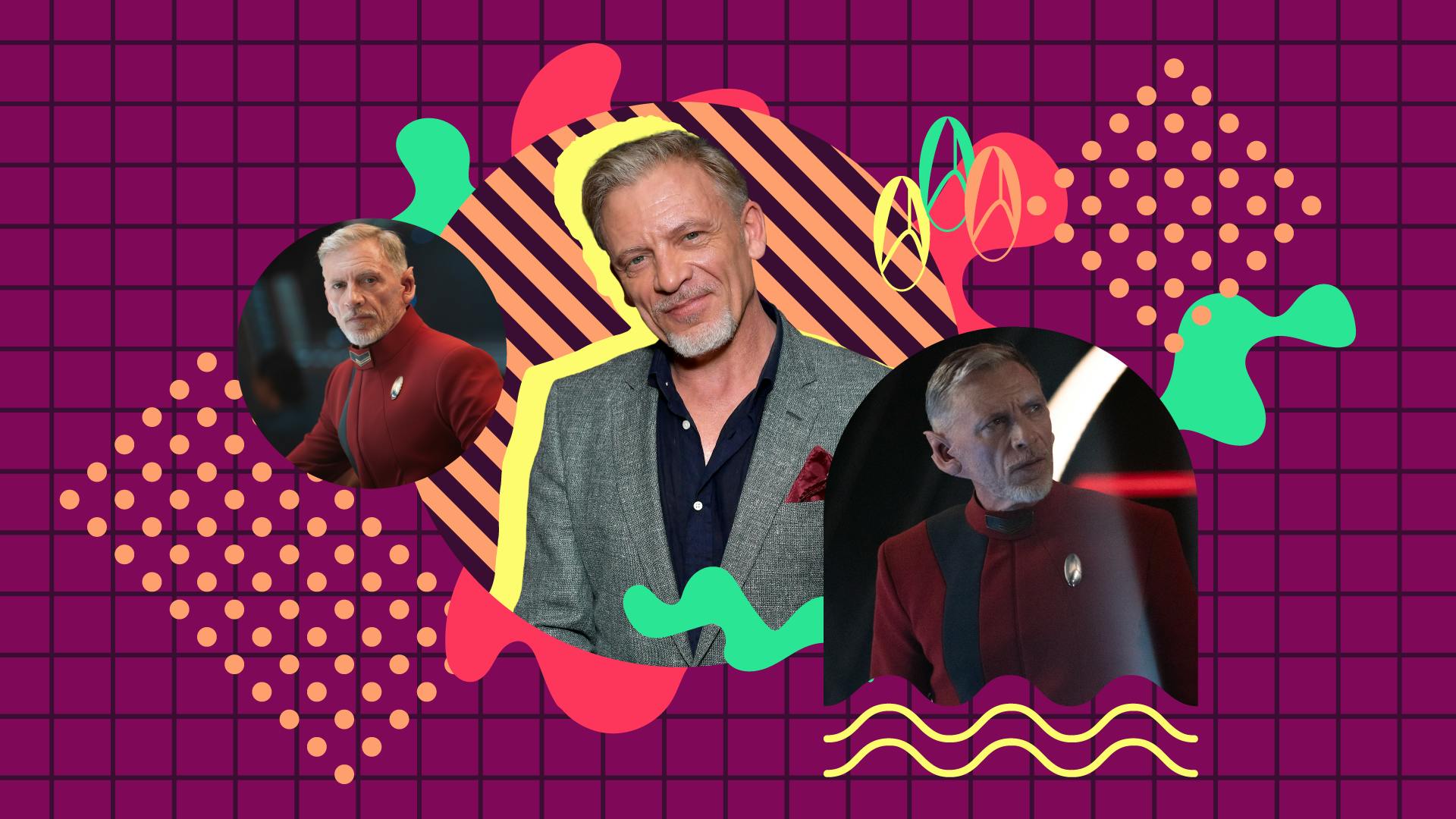

IMAGES
VIDEO
COMMENTS
The rank system of the Klingon Defense Force provided a hierarchy and chain of command for Klingon warriors and officers. Should the an officer become weak and unable to perform their duties, it was expected of the next in line to assassinate them to ensure an "honorable retirement," such as a first officer killing a commanding officer, or a second officer killing the first officer. By the ...
Klingon patrol officers. By 2259 in the alternate reality, after Starfleet's first contact with the Empire, the Klingons had conquered and occupied two planets known to the Federation and fired on Starfleet ships half a dozen times. Tensions between the two powers were high and an all-out war was considered inevitable. During that year, before surrendering to the Federation, Khan Noonien Singh ...
The Klingons first appeared in Star Trek: The Original Series season 1, episode 26, "Errand of Mercy".Actor John Collicos, who played Kor in the episode, was the first TOS Klingon, and is largely responsible for their look, and the depiction of them as conquerors.Collicos took inspiration from Genghis Khan, which made the Klingons a more universal foe than the communist analogs they were ...
The only ranks ever mentioned in all of the series and movies were General, Captain, Commander and Lieutenant. The book 'Star Trek Klingon for the Galactic Traveler' lists those ranks plus Admiral, Commodore, Ensign, and Yeoman. All ranks, when possible, are listed with their Klingon names and their Federation rank equivalents.
Starfleet ranks were identifying titles of rank for the officers and enlisted members of Starfleet denoting the chain of command under both United Earth and the United Federation of Planets. These titles were generally adapted from earlier Earth naval forces. (TOS: "The City on the Edge of Forever", ENT: "Storm Front") By the development of the NX-Alpha in 2143, the Starfleet rank structure ...
Secondly, Klingons don't track things this way and your rank aboard a Klingon vessel is the same as your social standing. Promotions are offered to crew who have a high Reputation, as described in the Star Trek Adventures core rulebook. Because it's easier to get successes on your Reputation roll as a high-ranked class like the Nobles or ...
The Klingons (/ ˈ k l ɪ ŋ (ɡ) ɒ n / KLING-(g)on; Klingon: tlhIngan [ˈt͡ɬɪŋɑn]) are a fictional species in the science fiction franchise Star Trek.. Developed by screenwriter Gene L. Coon in 1967 for the original Star Trek series, Klingons were swarthy humanoids characterized by prideful ruthlessness and brutality.Haling from their homeworld, Qo'noS (pronounced as "Kronos"), Klingons ...
For technical war-rant officers, it is yellow. For ESS officers, it is red. For KGB officers, it is black. For Army officers, it is brown. The next rank is K2, equivalent to a 1st Lieutenant or Star Fleet Junior Lieutenant. This is similar to K1 but has two bars. K3, equivalent to a Marine captain or Star Fleet senior lieutenant, has three such ...
The Starfleet ranks presented here were sourced from Stuart, Rick & Terra, John (1988).Star Trek The Next Generation Officer's Manual.Chicago: FASA Corporation. ISBN 1-55560-079-4.; The Klingon ranks presented here were sourced from Klingon for the Galactic Traveller (Marc Okrand, 1997.
While Klingons are thought of as the biggest antagonists in the history of the Federation, the majority of Star Trek stories take place when they are at peace. The end of Star Trek: The Original Series era of films included the beginnings of an alliance initiated by Spock and Captain Kirk, though reluctantly. While peace was never easy or all that long-lasting, the Klingon Empire and Starfleet ...
Rank Comparisons. The Klingon Defense Force rank structure was largely a holdover from that of the Klingon Imperial Fleet, at least so far as officer grades are concerned. Combining ground and air/space operations into the KDF's mandate required formalization of enlisted ranks for ground troops as well as ship-based support personnel.
In Star Trek Online, ranks denote the level of a character or NPC. Ranks are taken from those ranks used in Star Trek which they themselves, in the case of Starfleet are derived from the U.S. Navy. Higher ranks denote more powerful NPCs and unlock new abilities and systems to the player. A player's character progress through various ranks, comprised of between 5 and 10 levels. The character ...
Flag Officers. Admiral. Admiral ( FASA 2002 ) Thought Admiral. A Thought Admiral is a fleet grand strategist. Though he is not in direct command of naval vessels, a Thought Admiral stands, theoretically at least, above all other naval officers in matters involving long-range planning. [1]
See Bajoran ranks and Klingon ranks. As with commissioned officers, there was a rank structure among enlisted crew. ... in Fletcher's personal notes (p. 11), he indicated that "there is no warrant rank," however, in a later 2 June 1987 '"Star Trek" Cast Ranks' memo from Rick Berman to Bill Theiss, the intention during TNG was to have warrant ...
Faction "Lock". When you get your reputation with any of the factions to 10 million, it will lock, meaning that it will never fall below 10 million. No matter how many ships you kill, or missions you do, the lowest your faction rep will go will be 10 million. Dual faction lock and triple faction lock will open up a lot of ships and ...
While Star Trek boasts a number of recurring, non-human races in Starfleet ranks as well as adversaries for the Federation, it's the intriguing and diehard warrior race of the Klingons which has most captured Trekkers' imaginations throughout the varied series and movies. Related: The 10 Best Star Trek Klingon Episodes
A previously-played Klingon ship was the IKV Dreamslayer. On this ship, ranks were displayed in the character's profile in Klingonese. Rank Caps. Though the Klingons are no longer a playable faction on Federation Space, historically players were capped at Lieutenant.
The ranks of the Klingon Defense Force were codified by the Klingon High Command, derived from military titles and ranks of lore and tradition. The militaries of the Great Houses share the rank system, the holders expected to bear equal prestige and authority. This allows for easy cohesion of all Klingon military forces should the KDF gather the Deep Space Fleet.
Klingon Defence Force Ranks. The rank system of the Klingon Defence Force bears some resemblance to various Earth ranking systems. A ceremonial sash of varying design and material is worn by commanding Klingon warriors to show rank and status in society. The sash can be made of many materials, most commonly of gold thread or silver metal.
Worf and Klingon General Martok first encountered each other in a Dominion prison camp. They helped each other survive and subsequently fought side-by-side in the Dominion War. ... Sam Kirk served aboard the flagship under Captain Pike as his younger brother was rising the ranks aboard the Farragut. ... Star Trek: Discovery Seasons 1-4 are ...